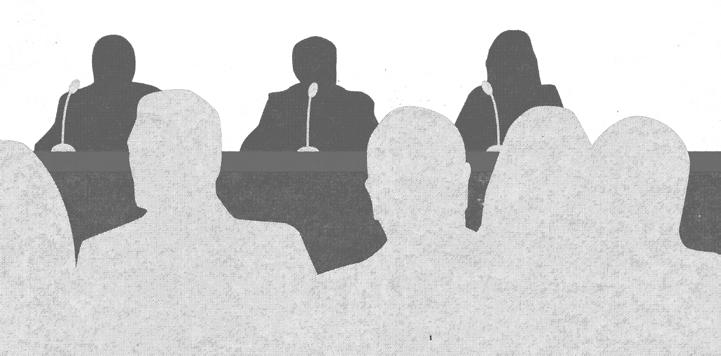
THE OFFICIAL UNIVERSITY OF MANITOBA STUDENTS’ NEWSPAPER March 1, 2023 Vol. 109, No. 23 UMSU CANDIDATES — SPECIAL NEWS FEATURE ONE YEAR ON AND THE WAR IN UKRAINE CONTINUES — PAIZEN * * * * * * ACADEMIC DISHONESTY LEVELS REMAIN HIGH — PUCHNIAK * * * * * * BISONS LOSE BASKETBALL SEMI FINAL AFTER CONTROVERSIAL COUNTED BASKET — BRANDT The Manitoban
EDITOR-IN-CHIEF ? editor@themanitoban.com
Gillian Brown
BUSINESS MANAGER ? accounts@themanitoban.com
Dhruv Patel
ADVERTISING CO-ORDINATOR ? ads@themanitoban.com

Richard Plant
MANAGING EDITOR ? me@themanitoban.com

Grace Anne Paizen
COPY DESK ? copy@themanitoban.com
Ezra Taves (ed.)
Morgan Heck
NEWS DESK ? news@themanitoban.com
Colton McKillop (ed.)
vacant (ed.)

Kasey Pashe
Ashley Puchniak
Alicia Rose
RESEARCH & TECHNOLOGY DESK ? research@themanitoban.com
Elah Ajene (ed.)
Robert Moshe Thompson
COMMENT DESK ? comment@themanitoban.com
Sarah Cohen (ed.)
Braden Bristow
Dina Hamid
ARTS & CULTURE DESK ? arts@themanitoban.com
Alex Braun (ed.)
Damien Davis
Jessie Krahn
SPORTS DESK ? sports@themanitoban.com

Joshua Brandt (ed.)
Quinn Mayhew
PHOTO DESK ? photo@themanitoban.com
Ebunoluwa Akinbo (ed.)
Faith Peters
DESIGN DESK ? design@themanitoban.com
Matthew Doering (ed.)
Taeran An
GRAPHICS DESK ? graphics@themanitoban.com
Dallin Chicoine (ed.)
Jenna Solomon
AUDIO DESK ? audio@themanitoban.com
Harmatpreet Brar (ed.)
SOCIAL MEDIA DESK ? social@themanitoban.com
Jory Thomas (ed.)
Violet Baker
VOLUNTEERS THIS ISSUE ?
Matthew Merkel
VOLUNTEER STAFF ?
Lucas Gomes interested in volunteering?
email me@themanitoban.com today!
THEMANITOBAN.COM
109 HELEN GLASS BUILDING
UNIVERSITY OF MANITOBA WINNIPEG, MB
204. 474. 6535
The Manitoban is the official student newspaper of the University of Manitoba. It is published monthly during the summer and each week of regular classes during the academic year by the Manitoban Newspaper Publications Corporation.
The Manitoban is an independent and democratic student organization, open to participation from all students. It exists to serve its readers as students and citizens.
The Manitoban is a member of the Canadian University Press, and our journalistic standards can be found on the Manitoban’s website.

The newspaper’s primary mandate is to report fairly and objectively on issues and events of importance and interest to the students of the University of Manitoba, to provide an open forum for the free expression and exchange of opinions and ideas and to stimulate meaningful debate on issues that affect or would otherwise be of interest to the student body and/ or society in general. The Manitoban serves as a training ground for students interested in any aspect of journalism.
Students and other interested parties are invited to contribute to any section of the newspaper. Please contact the appropriate editor for submission guidelines.
The Manitoban reserves the right to edit all submissions and will not publish any material deemed by its Editorial Board to be discriminatory, racist, sexist, homophobic or transphobic, ableist or libellous.
Opinions expressed in letters and articles are solely those of the authors. Editorials in the Manitoban are signed and represent the opinions of the writer(s), not necessarily those of the Manitoban staff, Editorial Board or the publisher.
A “volunteer staff” member is defined as a person who has had three volunteer articles, photographs or pieces of art of reasonable length and/ or substance published in the current publishing year of the Manitoban.

Any individual who qualifies as a volunteer staff member must be voted in by a majority vote at a Manitoban editorial board meeting. Elected representatives and non-students may be excluded from holding votes as volunteer staff members in accordance with the Manitoban Constitution.
All contents are ©2023 and may not be reprinted without the express written permission of the Editor-in-Chief.

News Special Feature pages S1 to S8, after page 12
Feature pages 3 and 16
Research & Technology pages 4 to 5

Editorial page 6
Comment pages 8 to 12

Diversions
pages 13 to 14
Arts & Culture
pages 18 to 20
Sports
pages 21 to 24
2 Vol. 109 No. 23
U of M and the case of academic misconduct
Multiple factors may contribute to higher levels of academic misconduct
Ashley Puchniak, staff
There has been a significant rise in cases of academic misconduct at the U of M since the start of the COVID19 pandemic. According to a recent report published by the University Discipline Committee (UDC) the 2021-22 academic year saw a continuation of those high case numbers.
There were 1,127 incidents of academic misconduct from Sept. 1, 2021 to Aug. 31, 2022, a sizeable increase from the 626 reported incidents just five years ago in the 2017-18 academic year. Most of last year’s cases consisted of inappropriate collaboration, plagiarism and cheating.
Sheryl Zelenitsky, chair of the UDC, acknowledged that with the start of the pandemic, the 2019-20 academic year saw an increase in academic misconduct by about 40 per cent. However, she said that it should not be assumed that academic dishonesty will decrease now that students are back on campus, as the UDC does not yet have a full report regarding the current school year for comparison.
“I think we can’t jump to conclusions until we do have at least a year of data where we’re back in person,” Zelenitsky said.
Another member of the UDC is John Anderson, a professor of computer science at the U of M who specializes in robotics. He believes that the emergence of AI technology could have future implications regarding academic misconduct.
He explained that these systems could be developed for various purposes, such as writing essays, solving systems of mathematical equations or providing in-depth analysis of Shakespeare.
Anderson noted that the UDC does not have meetings on a regular basis to discuss such issues. Rather, the committee primarily functions to hear appeals of lower-level disciplinary decisions.
However, Anderson thinks that the issue of AI-related misconduct could become a cause of concern for the UDC in the future.
“I suspect it will be on the minds of some senators and some in the administration, and perhaps encouraging the committee to also meet to deal with issues like this (or altering the terms of reference to explicitly point that out) might happen at some point,” he wrote in an email to the Manitoban
However, UMSU president
“If we reach a critical point where many students come to believe that everyone is cheating, then I think the game is lost”
— Arthur Schafer, founding director of the Centre for Professional and Applied Ethics
Jaron Rykiss highlighted the fact that there are many factors that may drive students to cheat.
Rykiss said via email that he believes as a result of online learning, the university has “several cohorts of students who have not had the proper resources and experiences required to ensure that they feel prepared for learning.”
He thinks that this “may have pushed students who would have otherwise never considered cheating to see it as their only option to succeed.” However, he emphasized that academic misconduct is never a viable option for students.
He believes that stress is a factor in academic dishonesty, and said that the university should work to ensure
resources meant to help students succeed and manage stress are sufficiently funded, updated and accessible.
“Students need to feel supported in order to support themselves,” he said.
The main job of the university according to Arthur Schafer, professor of philosophy and founding director of the Centre for Professional and Applied Ethics at University of Manitoba, is at this point to protect academic integrity and dissuade students from academic misconduct by making “the likelihood of detection high enough and the rewards from cheating low enough” that students are not incentivized to cheat.
The reason for the rise in misconduct cases, he said,
could come down to simple human psychology.

“When you increase the opportunities to cheat and decrease the likelihood that the cheating will be discovered, it’s to be expected that there will be more cheating,” he said.
Schafer argued that the competitive and individualistic nature of our society is a factor that may encourage academic dishonesty.
He used the example that a student with a GPA even slightly lower than another student may lose out on admittance to competitive educational programs like medicine, law or engineering.
a loser, and that the rewards for being a winner are dramatic,” he said.
Given this cultural atmosphere surrounding students, Schafer reiterated that he does not find it surprising that more students are cheating.
He said that students don’t want to be disadvantaged simply for following the rules.
“If we reach a critical point where many students come to believe that everyone is cheating, then I think the game is lost.”
“The culture tells us repeatedly in all sorts of ways, direct and indirect, that the worst thing that can happen is to be features@themanitoban.com
3 features@themanitoban.com March 1, 2023 Features
graphic / Dallin Chicoine / staff
The importance of women’s heart health
Researcher raises awareness on women’s heart health
Robert Moshe Thompson, staff
There is a misconception among the general public that women do not have heart attacks.
In the media, heart attack patients are most often portrayed with classic heart attack symptoms such as chest pressure and heaviness. Women often experience lesser-known heart attack symptoms including sharp pain in the jaw, back or other areas, nausea or shortness of breath.
This misrepresentation can lead women to avoid seeking medical attention, thus delaying diagnosis and treatment.
U of M assistant professor in the Max Rady college of medicine and interventional cardiologist Shuangbo Liu emphasized the importance of patients seeking help for a possible heart attack immediately.
“When it comes to a heart attack, definitely every minute counts,” she explained.
Women’s heart health is an important pillar of Liu’s research.
As a clinician scientist, she mostly studies spontaneous coronary artery dissection (SCAD), which is when a tear occurs in the lining of a blood vessel in the heart, causing poor blood flow to the heart
and potentially resulting in a heart attack. About 80 per cent of her clinical patients have this condition.
The condition occurs about nine times more frequently in females than in males.
SCAD has symptoms that are similar to a heart attack, such as chest pain and shortness of breath. It often occurs when patients are relatively young, usually in their early 40s.
Moreover, SCAD patients often lack pre-existing risk factors for heart disease, such as diabetes or high blood pressure.
People who feel that they are not at risk for heart issues might be less likely to seek help for heart attack-like symptoms.
This particularly affects women, young people and those who are otherwise healthy. These groups are also more likely to believe that their symptoms will go away if they just ignore them.
Elderly people, who often have atypical heart attack symptoms, may also delay in seeking medical attention.
SCAD also requires more specialized care than other heart conditions. The condition is somewhat rare, which is why Liu is setting up a local
registry of SCAD cases with details on their treatment and outcomes.
The local registry can be compared to registries like it in other areas, thus increasing the knowledge of the scientific community.
Liu is also part of a public awareness campaign called “Dial, Don’t Drive,” which encourages patients to call 911 as soon as they start experiencing symptoms of a heart attack instead of attempting to drive themselves to the hospital. This allows those suffering from a heart attack to begin receiving medical care as soon as emergency services reach them, instead of upon arrival at a hospital.
The awareness campaign is taking place on social media, in newspapers and even through bus ads.
Liu said that according to local data, about 53 per cent of Winnipeggers who had a heart attack called 911. This means that nearly half of patients had their treatment delayed by driving themselves or having a family member drive them to the hospital.
Liu also supports an event called Wear Red Canada, which seeks to raise awareness about women’s cardiovascular health. Every year on
Feb. 13, participants wear red clothes and attend events that discuss and raise awareness concerning heart issues that women face.
Initiatives such as these are important because delaying treatment can have serious consequences for heart attack victims.
If the affected artery in a heart attack is completely blocked, leaving it untreated can result in permanent damage to the heart muscle. Patients might also have heart failure and may die without proper care.
Some people feel that they cannot control the possibility of having a heart attack because of their age or family history. However, Liu explained that this is not the case, and advised that risk can be reduced through exercise, maintaining a healthy diet and avoiding smoking and excess alcohol consumption.
Although the general public may lack knowledge about heart attacks, physicians are trained to recognize atypical symptoms. Advanced diagnostic tools can detect even very minor heart attacks.
However, scientists are still unsure about why males and females present with heart attack symptoms differently.
This question is complicated by the fact that women do present with heart attack symptoms like chest pressure, though not as often as men.
Another issue in the field is that treatments for heart attacks were traditionally tested on men. This leaves doctors with less knowledge on how treatments affect women.
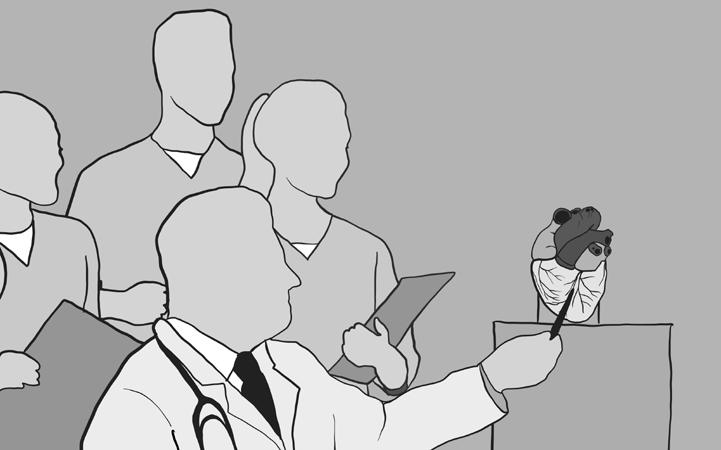
Liu hopes that her investigations will improve public knowledge regarding how to respond to a heart attack.
“When it comes to heart attacks and chest pain, I really want people to understand that time is muscle, and that seeking help sooner and through the appropriate method such as calling 911 is very important,” Liu said.
She also hopes that her research regarding women’s heart health will help to spread awareness about heart attacks in women, and really empower them “to understand what are the typical symptoms, atypical symptoms, and not to be afraid to seek help.”
research@themanitoban.com
Research & Technology 4 research@themanitoban.com Vol. 109, No. 23
graphic / Dallin Chicoine / staff
Fostering patient-centred care
Researchers discuss innovative technologies in health care at Café Scientifique
Elah Ajene, staff
On Feb. 22, the University of Manitoba’s Café Scientifique hosted a session on innovative health-care technologies and their use in understanding and improving patient experiences.
The panelists included a team of interdisciplinary researchers who spoke on developments in health-care technology since the onset of the COVID-19 pandemic, and on how those developments have provided more accessible and patient-centred care.
U of M assistant professor in the department of psychiatry and Health Sciences Centre and Crisis Response Centre staff psychiatrist Jennifer Henzel discussed the expansive growth of telemedicine and virtual care in Manitoba.
The provision of virtual medical care has been applied in the health-care industry for decades. However, Henzel noted that virtual care was done in very limited ways before the COVID-19 pandemic, especially in psychiatry.
“That was an area that there wasn’t a lot of comfort and experience dealing with people who are in their home as opposed to in a health-care setting,” she said.
Henzel said that the pandemic pushed those in psychiatry to make advancements in virtual care, and that those advancements have been promising.
“There were a lot of skeptics before the pandemic, and I think now everybody is realizing that this is something that has significant potential in health care,” she added.
Recently, Henzel helped launch an emergency rural telepsychiatry service, which offers virtual assessments for those experiencing a mental health crisis in rural Manitoba. Since being introduced in 2021, the service has received about 500 calls.
“We’re avoiding unnecessary transfers, hospitalizations and bringing care to people in their home communities,” Henzel said.
Additionally, she assisted in the implementation of a virtual hospital for mental health crisis stabilization, offering intensive online support to those at home in need of assistance.
Henzel highlighted the emergence of cognitive behavioral therapy and mental health and wellness apps to assist with things like self-monitoring and the development of coping skills.
Institutions like CancerCare Manitoba have adopted
apps such as Noona, which allows patients to provide real time input directly to their clinical team regarding the symptoms they are experiencing.
Although the use of these technologies is now widespread, U of M assistant professor and Rady chair in interprofessional collaborative practice Gayle Halas pointed out that there was initially a low use of technology in patient-provider communication prior to March 2020 in Canada.
“During the height of the COVID pandemic and when we were faced with physical distancing measures for public protection, not only was this a new means for visiting health-care providers during COVID, but it was the dominant option for addressing health-care concerns,” Halas said.
Halas brought together a multi-disciplinary team to investigate the rapid introduction of virtual visits in health care.

The team obtained nearly 700 surveys for analysis and ran nine focus groups speaking with patients and caregivers that discussed the ease
or difficulty of virtual care, the quality of virtual visits and how virtual health care might proceed in the future.
Overall, Halas’s team found that virtual care was a suitable complement to in-person consultations.
“Participants believed that virtual care did have a place in
Health quality and patient-reported measurement lead at the George & Fay Yee Centre for Healthcare Innovation Sarah Kirby also emphasized the importance of patient feedback and its contribution to more patient-centred care.
This includes using what are known as patient-reported measures — extensively tested surveys that can be used as standardized tools to understand patients’ experiences during service, as well as their care outcomes.
the health system and that [it was] better suited to address some issues over others, but that patients should be given a choice based on their preferences, and this could perhaps even be together in consultation with their provider,” she said.
Halas said that her team wanted to highlight the importance of patients’ reported experiences with their research.
“It is essential that we get this kind of feedback and that it is obtained from those most impacted by system changes, like the rapid introduction of virtual care,” she said.
Kirby noted how the focus that the retail industry has regarding the use of feedback-based data to improve products and services could be applied within the world of medicine.
“In a publicly funded health-care system where we report to be patient-centred, and where we’re facing a lot of struggles going forward with resource allocation, especially post-pandemic, it seems to me that it makes sense that we would include patients and the public’s perspective when we’re measuring our health-care resource distribution, and to learn more about whether the health-care
services that we’re providing are meeting the needs of patients,” Kirby said.
Kirby explained that by using patient-reported outcome data alongside other clinical data, a more complete story of how our healthcare system functions can be shown, and can be used to inform bigger policy decisions.
Kirby emphasized that the continued adoption of technologies in the health-care system should be informed by the patients using them. She also noted the patient data that these technologies could provide.
“These technologies themselves are excellent tools that we can use to actually routinely collect information from patients about whether our care is meeting their needs, about whether they are having a good experience,” she said.
5 research@themanitoban.com March 1, 2023 Research & Technology
photo / Ebunoluwa Akinbo / staff
“Everybody is realizing that this is something that has significant potential in health care”
research@themanitoban.com
— Jennifer Henzel, assistant professor, U of M department of psychiatry
From left to right: Jennifer Henzel, Sarah Kirby and Gayle Halas.
The importance of planting flowers
Flowers should be sown, not purchased
Joshua Brandt, staff
By now, I think many Manitobans are likely quite weary of winter.
I know I am.
So take heart, for today on the first of March, spring — that elusive shrinking violet — has finally arrived. Well, meteorologically, that is.
And what does spring yield?
Flowers, of course.
In the spring and summer of 2021, I worked for a greenhouse. It was an enlightening experience overall, but greenhouses are not exactly what you’d expect.
A machine filled a pot with dirt. I put the pot on a conveyor belt and watched it slowly rattle off toward my co-worker, holding a label that she stuck in the soil. “Tomato.”
I couldn’t watch too long, however, as the machine was ready to belch out another load of nutritious soil.
Not a moment too soon, I grabbed another pot and slid it under the machine, filling it with earth. I then sent it down the conveyor belt. I grabbed another pot. I filled it. I sent it down the conveyor belt. I grabbed another pot…after a couple of hours and a cof-
fee break, we switched. Now I could plant.
It wasn’t much different. The pot slowly rattled toward me. I grabbed it and shoved my fist into the soil, making a hole. I then extracted a young tomato plant from its planter and delicately placed it into the hole I’d created.
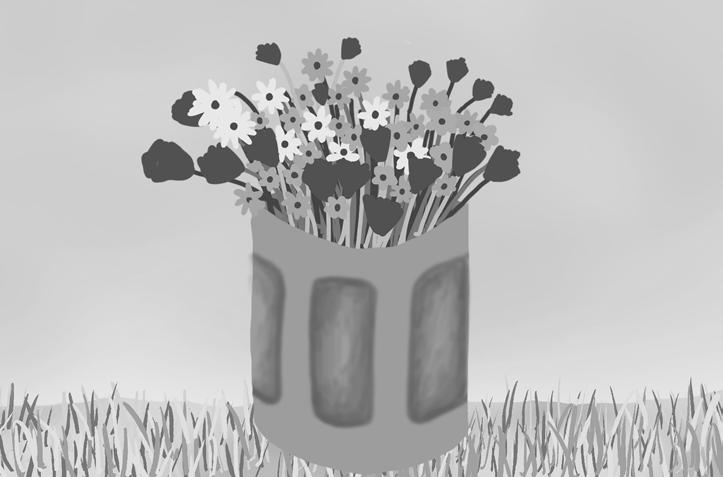
Giving it a spritz of water while smoothing over the top layer of soil with my fingers, I’d hand it to another co-worker who placed it on a trolley, which they would wheel off to one of the many storage greenhouses once it was full.
It was insipid, tedious work.
Strolling through the picturesque ecological grandeur of a greenhouse’s showroom is entirely deceiving.
Every plant is strategically placed. Every flower is blooming in radiant health. There isn’t a weed in sight.
Well, that’s because we used the herbicide Par III to kill any weeds. Every flower looks lovely because only the best make it to the showroom.
The ones that didn’t make it were either taken home by a genial older co-worker of mine or tossed.
Overproduction was a serious problem. In any given year, a greenhouse doesn’t know exactly how many plants people will buy. Plants take time to grow, so a greenhouse must have a surplus or risk running out of flowers.
And a surplus we produced.
I remember one rainy afternoon near the end of August that I spent chucking countless unsold petunias (your aunt’s favourite) into our old stick-shift garbage truck.
Drenched to the bone, I wondered what in the world I was doing.
I was getting paid to throw away flowers.
Something was wrong.
Thus end my greenhouse memoirs. However, they illuminate an important issue — namely, purchasing commercialized plants. Though convenient, it isn’t really a rewarding thing to do.
This is because flowers from many stores are mass-produced. Purchasing them to display in your yard or home is to indulge in instant pleasure seeking, attempting to circumvent the healthy ecological interim period in which delayed gratification is
fostered.
Instead of opting for this expediency, I’ll always champion the buying and planting of seeds oneself. In this case, you’re in it for the long haul. From the moment a flower sprouts to the moment it blooms, you’ll be more invested, and that is a good thing.
In short, it is important to plant flowers because they’re beautiful. You don’t need a better reason than that. But what is really important is that you are the one planting them.
It is, in a way, more natural and pure — wholesome, even.
It’s also much cheaper to buy seeds than fully grown flowers.
You may feel that you’re unable to plant flowers, as you live in the city with no yard or in a cramped apartment. However, you still can.
All you’ll need is a little box, preferably wooden and rectangular, which you can place on a windowsill or sun-soaked ledge.
Next, you’ll need some soil. You can get this anywhere — your local grocery store may even stock it. But a green-
house or hardware store will certainly have it.
Finally, seeds. Please get the seeds, not the plant. There are several excellent local seed suppliers. Personally, I’d recommend Prairie Originals or Sage Garden Greenhouses.
The package of seeds should include instructions on how to plant them. If you’re into local things or don’t feel like you have a particularly green thumb, try to find flowers indigenous to Manitoba such as the Western Canada violet, Woods’ rose, anise hyssop, evening primrose, prairie crocus, bluebells or the crowfoot violet.
Finally, if you’re just unsure where to start, you could take my drab advice and plant flowers that I think are especially aesthetically pleasing, like baby’s breath, black-eyed Susans, lupins and asters. Do it to make the world infinitesimally more beautiful. We all know how hideous it can be.
editor@themanitoban.com
Editorial 6 editor@themanitoban.com Vol. 109, No. 23
graphic / Jenna Solomon / staff




UMSU.SIMPLYVOTING.COM VOTING DAYS: MARCH 9-10, 2023 2023 UMSU Community Rep. Candidates FRIDAY MARCH 3, 12-3PM 2023 UMSU President Candidates WEDNESDAY MARCH 1, 12-2PM Hear from the 2023 UMSU Candidates! THE ENGINEERING ATRIUM UMSU Elections Forum 2023 UMSU Executive Candidates THURSDAY MARCH 2, 12-2PM NEW FAST GRAB ITEMS NOW AVAILABLE! Crispy Chicken Wrap Shrimp Salad Roll Tofu Salad Roll AVAILABLE UNTIL SOLD OUT 3RD FLOOR, UNIVERSITY CENTRE www.UMSU.ca @studentsofumsu
Racism is a public health emergency
Racism in the health care world is a deadly crisis that requires attention

Dina Hamid, staff
Systemic racism is an issue that plagues many different parts of society, including the health care system.
There is scientific evidence of health inequities that disproportionately negatively affect Black and Indigenous people both in Canada and abroad.
A growing body of research demonstrates that maternal mortality and morbidity rates are higher for Black women globally. Different studies have reported that Black women in the United States and the United Kingdom are three or four times more likely to die in childbirth than their white counterparts.
We can speculate that Canada would have similar patterns. However, due to Canada’s colour-blind approach to collecting data, it is not certain. Since there is a lack of racial data on Canadian maternal mortality, we cannot identify disparities in our health care system, which in turn can allow for racial inequities to continue unnoticed for longer.
Implicit biases and systemic racism in medicine are among the reasons why Black women have higher rates of
maternal mortality. Many Black women, including high-profile celebrities like Serena Williams, report being dismissed and not listened to when discussing their symptoms, concerns or pain with medical professionals.
This could be due to the long-held belief that there are biological differences between Black and white patients, which perpetuates the belief that Black people have a higher pain tolerance.
These beliefs are simply not true.
A 2016 University of Virginia study found that these false beliefs were shared and supported by half of white medical students and residents in a sample. This is extremely worrying because according to the same study, Black Americans are consistently undertreated for pain compared to white Americans.
When looking at research on racial health disparities in Canada, it is evident that Indigenous people have worse health outcomes than other races including higher rates of chronic illnesses and associated risk factors, double the rate of infant mortality, 30 per cent higher post-surgical death rates and an over-
all lower life expectancy.
These findings can primarily be attributed to systemic racism and racial biases in the public health care sector. This can result in quality health care and services being inaccessible to Indigenous people, particularly in rural areas and reserves.
Additionally, biases that are rooted in racist ideology put the blame for poor health onto Indigenous people without understanding or acknowledging how colonization, socioeconomic factors, generational trauma, racism and cultural oppression play a role in debilitating the health of First Nations communities.
A paper published by University of Manitoba associate professor Brenda L. Gunn briefly discusses the harmful effects of colonialism and its long-lasting repercussions. Examples of this include the spread of deadly new infectious diseases, the illegalizing of spiritual and medical practices and policies such as residential schools that have had generational effects on the well-being and physical health of Indigenous communities.
According to a June 2022 study, First Nations patients frequently experience neglect,
disrespect and overt racism when seeking care. This could result in false judgements due to harmful stereotypes made about Indigenous patients by non-Indigenous staff, which can change staff attitudes and the level of care they provide Indigenous patients. This is evident in the countless documented cases of Indigenous people dying of preventable causes.
In 2008 Brian Sinclair, an Indigenous man, was ignored for 34 hours by hospital staff in a Winnipeg emergency waiting room before he died of complications related to a treatable bladder infection because staff thought he was intoxicated or homeless.
Then, in 2015, Keegan Combes of Skwah First Nation was thought to be drunk when he came to a British Columbia hospital for help and did not receive proper treatment until it was too late, which is what ultimately led to his death of accidental poisoning.
In 2020, Joyce Echaquan, a 37-year-old Atikamekw woman, live-streamed her cries for help while hospital staff in Quebec taunted her, saying she “made bad choices” and making other racist remarks before she died of excess fluid in her lungs.
The lack of care and empathy for Indigenous and Black patients from health care providers further reinforces the mistrust that discourages them from seeking medical care. These people died because of racism, a public health emergency that threatens the health and therefore the lives of many Indigenous and Black people.
No one should be practising medicine who is racist. The fact that health care practitioners who hold these beliefs can slip though the wide cracks signifies a systemic and structural failure in the health care system to protect and serve its patients.
Work should be done to ensure that racial biases are addressed in medical academia and the workplace to guarantee that practising and future health care providers deliver quality care to all. Everyone is deserving of quality patient care that is free from prejudice and discrimination.
comment@themanitoban.com
Comment 8 comment@themanitoban.com Vol. 109, No. 23
graphic / Jenna Solomon / staff
THE 2023 ROBERT AND ELIZABETH Knight
What does it mean to be an equity-seeking student on a Canadian campus today?
Featuring Eternity Martis Journalist, assistant professor at TMU and award-winning author of They Said This Would Be Fun: Race, Campus Life, and Growing Up.

BANNATYNE CAMPUS | MARCH 8, 3:30-4:30 PM Frederic Gaspard Theatre, Basic Medical Sciences Building Registration not required
FORT GARRY CAMPUS | MARCH 9, 3-5 PM Investors Group Athletic Centre Public lecture, all are welcome. Please scan and submit your RSVP online at the following QR code umanitoba.ca/knight-lecture
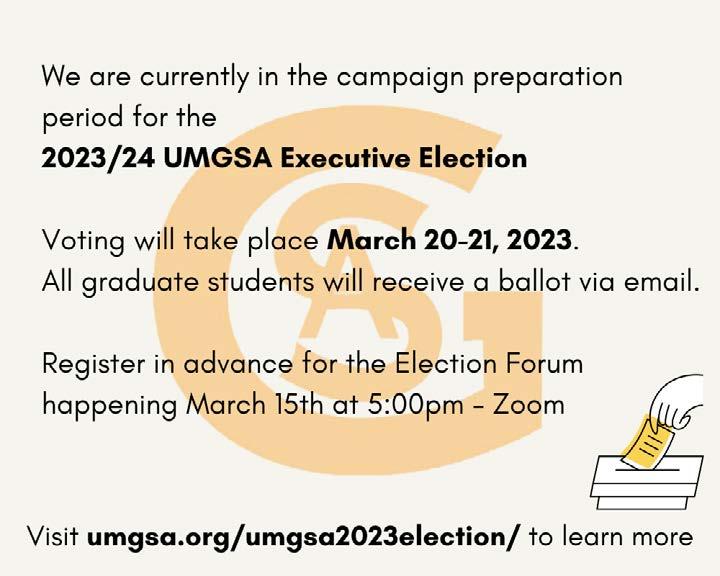 Distinguished Lecture
Distinguished Lecture
Why you should still care about Ukraine

All civilians are at the mercy of their governments’ interference
Grace Anne Paizen, staff
The African proverb goes, “when elephants fight, it is the grass that suffers.” It takes a war to understand that civilians are the grass who never asked for the conflict, and that the governments fighting are the elephants.
While Gen Z may grow weary of Millennials perpetually rehashing their trauma over 9/11, they should keep in mind that the event was, for most of our generation in North America at least, arguably the first time we realized that we as civilians were the grass.
While we had been fiercely educated on the world wars, it was the first time major history had reached the North American shores in our conscious memory, and was the result of elephant fights past between the government of the United States and the regime changes in the Middle East.
If this sounds familiar, it’s because the globe is currently in another elephant fight — or, at least, governments are. The West and the North Atlantic Treaty Organization (NATO) are against Russian President Vladimir Putin’s Kremlin and allies. In this conflict, Ukrainian civilians are the grass.
Most importantly, and why you should care, is because U of M students are just as much grass to be potentially trampled on if the fighting escalates.
When this article is published, it will be day 371 of the full-scale invasion of Ukraine, but the ninth year of a border war spurred by the Kremlin’s loss of control in the federal government of Ukraine as, in 2014, the EuroMaidan Revolution in Ukraine brought about independent democracy of the country from outside influences, namely pro-Rus-
Timeline of conflict in Ukraine
The EuroMaidan Revolution
November 2013 to February 2014
In November 2013, pro-Russian Ukrainian President Viktor Yanukovych refused to sign an agreement with the European Union, instead choosing closer political ties to Russia.
Protests in Maidan Nezalezhnosti (Independence Square) in Kyiv would last until February of 2014, eventually turning fatal.
On Feb. 27, a coalition party was formed to govern Ukraine.
Yanukovych fled to Russia, claiming to be the “rightful president of Ukraine.”
sia heads of state.
To not at the very least acknowledge that the Russian invasion of Ukraine that started on Feb. 24, 2022 is somewhat Putin and allies versus NATO would be ignorant. While Putin’s goal may be to restore the borders of the former Soviet Union or even the former Russian Empire, it would be also ignorant to ignore the resources in Ukraine that Putin’s Kremlin is after.
The town of Soledar in the Donetsk oblast (province) was recently captured by the Russian army because it is a salt mine town.
The Donetsk oblast alone contains at least two promising lithium deposits, with eastern Ukraine speculated to have around 500,000 tons of lithium oxide.
Annexation of Crimea
Feb. 27 to Mar. 18, 2014
On the heels of the EuroMaidan Revolution, Russia annexed the Crimean peninsula from Ukraine’s control.
“Green” technologies require lithium batteries, and conflict zones could potentially grow as the West switches over to the also pollutive system of battery and re-chargeable technologies.
It is not just over borders, then, but potentially the ageold colonial battle of resources for the Russian economy — just to showcase how everything is always connected.
So, how are students living in Winnipeg part of this conflict, and how are they potential grass to be trampled on? The answer is that it has been mainly NATO countries supplying defensive weapons to Ukraine.
In fact, the elephant fight in this war has very much become Putin and allies versus NATO with the civilians of Ukraine trampled daily by Russian shelling.
Students should care about
Establishment of the Russian-run DPR and LPR
February to April 2014
Pro-Russian protests began in the Donetsk and Luhansk oblasts — collectively known as Donbas.
On Apr. 7, Russian proxies seized the Donetsk Regional State Administration and declared the illegal Donetsk People’s Republic.
On Apr. 12, Russian proxy forces invaded Donbas, establishing Russian-run local governments and declaring the illegal Luhansk People’s Republic on Apr. 27.
this conflict on the basis that Canada is a member of NATO, and NATO members are actively providing support to Ukraine. Canadian tax dollars are actively at war with Russian artillery.
What’s more, we may be able to watch the elephant fight from afar at the moment, but in an instant, the elephant fight can come crashing into our own country with a nuclear escalation.
In the meantime, civilians should know and care about every armed conflict currently taking place in their world so that, at the very least, we can be prepared for an elephant fight we never asked for trampling through our doorstep.
comment@themanitoban.com
Full-scale Russian invasion of Ukraine
Feb. 24, 2022 to present
On Feb. 24, Russia began their full-scale invasion of Ukraine. Putin claimed he could “take Kyiv in three days” in leaked documents. On June 23, Ukraine was officially granted European Union candidate status.
Since the start of the full-scale invasion, Ukraine has won the Battle for Kyiv on Apr. 2, the Battle of Kharkiv on Sept. 16 and the Battle of Kherson on Nov. 11.
Currently, Russia only controls roughly 17 per cent of Ukraine’s territory.
10 comment@themanitoban.com Vol. 109, No. 23 Comment graphic / Jenna Solomon / staff
“When elephants fight, it is the grass that suffers” – African proverb
There’s still COVID on the planes
The limbo between pandemic and normal life
Sarah Cohen, staff
D uring reading week, I took an international flight and two U.S. domestic flights. In my anxiety-driven observations of people in and around the airport, I noticed an abundant lack of masking as my flight playlist blasted the line, “but there’s COVID on the planes” from Noah Kahan’s “Stick Season” into my AirPods. That is when I realized that three years into the pandemic, people have either stopped caring or care too much about how they are perceived when wearing a mask.
I must admit, being home in California or even out and about in Winnipeg, I’m often inclined to not wear a mask. My reasoning is based on my vaccination status and my exhaustion with the pandemic and the various mask mandates in the places I frequent, but should there be a change in the status of the COVID-19 pandemic I would abide by any regulations established to keep myself and my community safe.
I stayed masked in my KN95 throughout my flights, and I thought maybe other people would have common sense. But my 50-minute flight from Oakland to Ontario, Calif. was littered with unmasked individuals coughing, sniffling and talking all around me. I was left wondering — why are people choosing to go maskless in such close quarters?

I could assign blame to political figure undermining science and wanting countries to “get back to the normal day-today,” but what is there to support that? It could be a shared “my body my choice” ideology that has been used by both sides of the political spectrum — the left wanting bodily autonomy for reproductive health and the right wanting the freedom to choose to wear
a mask or not. But that gets into tricky territories.
I think this goes beyond politics, though. The Guardian published a story on masking where one interviewee said that they wore a mask for the sake of others’ COVID anxiety, but that as soon as they noticed that others had stopped wearing a mask in public, they stopped as well, even calling mask-wearing a “bit of theatre.”
I definitely think I conform to that idea. I typically wear a mask based on whether others are wearing them.
That is when I stumbled across “herding,” a social theory that refers to when individuals will follow group behaviour rather than mak-
ing decisions independently. Herding usually occurs as a response to uncertainty or plain ignorance about a certain event.
That makes sense. When we
are unsure of the state of the world, as I think many of us are, we would all become followers. What happens when the next pandemic hits?
It’s nearly inevitable that there will be another pandemic in the future. Hopefully not in our lifetimes, but researchers believe that the chance of there being a new pandemic each year is about two per cent.
Looking back at recent history, one of the most wellknown and detrimental pan-
demics was over a hundred years ago in 1918. That pandemic, which involved an H1N1 influenza strain, killed an estimated 50 million people. But according to the Centers for Disease Control and Prevention, there had also been influenza pandemics in 1957, 1968 and 2009.
So, then, what happens next? I was alive in 2009, but I don’t remember that pandemic having as much of an impact on my life as COVID. Nothing came to a grinding halt. What happens now with COVID? It feels like it’s over. Everyone is acting like it’s over. It is not and won’t be until the World Health Organization declares the global health emergency over.
devastating pandemic, what will we do?
I have no idea. Life won’t ever be the same. There will be people who are extremely vigilant about their health and others that will take the opportunity to bash science. No matter what happens, please, please listen to mask mandates when they are put in place. Especially in places where you are in constant, close contact with people who may be at risk, like here at the U of M. It is more than okay to not follow the herd.
Until then, and in the years between now and the next comment@themanitoban.com

11 comment@themanitoban.com March 1, 2023 Comment
graphic / Jenna Solomon / staff
It is more than okay to not follow the herd
What I want out of UMSU
Financial and social advocacy should be UMSU’s biggest concern
Braden Bristow, staff
The annual general election for the University of Manitoba Students’ Union (UMSU) is afoot. This means that our current UMSU executive and community representatives are on their way to greener pastures, and following the vote itself on March 9 and 10, a new team will step into the roles beginning in May.
I would encourage all students to stay informed and vote for the best candidates, but what does the best candidate or executive body look like? And what should UMSU do for us?
Well, in this columnist’s opinion, the best candidates are those who will stand up for students when it comes to financial and social advocacy.
Let’s first focus on the financial aspect. Inflation rates across Canada are rising. Between April 2021 and April 2022 there was an inflation increase of 6.8 per cent. This inflation also disproportionately affects international stu-
dents. On a more local level, the University of Manitoba approved a tuition hike that averaged out to 3.7 per cent for the 2022-23 academic year.
UMSU is in the perfect position to combat tuition hikes and ease the financial burden on students. The union could make efforts to oppose tuition hikes and continue to support programs that help students in tough financial situations.
The student body is not a monolith, but inflation and tuition increases affect us all, especially those less fortunate than others. UMSU should engage in organizing to mobilize students into protests or fundraisers to combat measures that hurt the financial well-being of students.
Now onto social advocacy. As a university campus, the U of M should be a place for the free exchange of ideas and a place where people feel safe and comfortable. The university’s own website states that
academic freedom, equity and inclusion are part of the school’s values. UMSU is in an excellent position to uphold and fight for these values wherever possible.
For example, there have been groups that have protested on campus while dis-
be escorted off the premises. These individuals have a right to their speech but not a right to display gore on public property.
playing graphic images of aborted fetuses — images intended to shock and upset students.
In my opinion, this is an outright attempt to upset and intimidate people into believing propaganda. I have personally walked past such protestors and have seen no effort to stop them or have them removed from campus. Having protestors that loiter on campus attempting to upset or disturb people violates the university’s supposed values of inclusion and respect.
UMSU can, and should, demand that these protestors
Though this is a singular example, there are numerous other issues facing women, racialized people, Indigenous peoples, 2SLGBTQIA+ people and the general student body that could be impacted by UMSU advocacy.
This combination of financial protection and social advocacy is the most important thing that UMSU can do for the student body. I strongly encourage the candidates and students who may read this to keep that in mind.
The best thing that UMSU can do for us is to lighten our financial burden and back us up when we need it. Financial and social solidarity are critical, and I, for one, would direct my vote to whomever can promise and achieve that.
I think it is also import-
ant to say that UMSU as a students’ union has a responsibility and a duty to be more than just an advocacy group. A union needs to stand up for and protect students across campus.
Whichever candidates end up winning the general election and make up the next executive body of UMSU need to do right by students even when it is difficult or unglamorous.
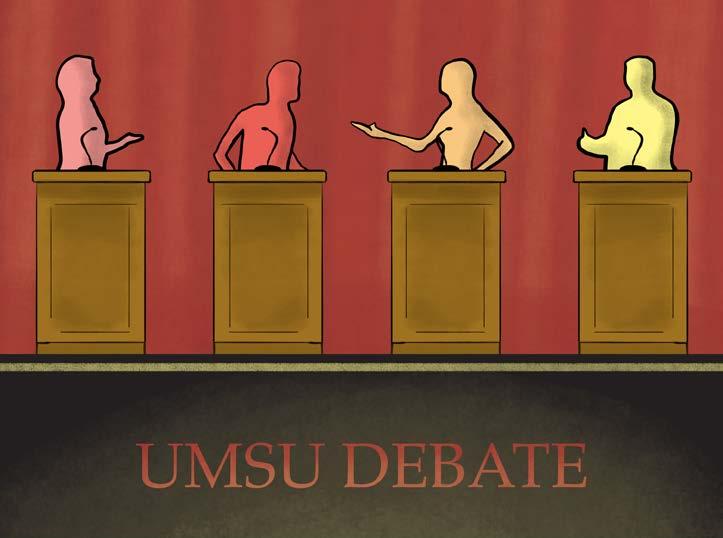
I know it is a tough position being a representative for the student body, but that position comes with responsibilities and duties to the people who elected you.
A union, even a students’ union, is more than a social group or a clubhouse. A union is the only line of defence between those who send out commands and those who have to follow them.
comment@themanitoban.com
12 comment@themanitoban.com Vol. 109, No. 23 Comment
A union, even a students’ union, is more than a social group graphic
/
Dallin Chicoine / staff
UMSU Candidates 2023


















 by: Colton McKillop, Kasey Pashe, Alicia Rose, staff
by: Colton McKillop, Kasey Pashe, Alicia Rose, staff




The Manitoban Vol. 109, No. 23 March 1, 2023
The Candidates
The Debates
Presidential Candidates
Roleen Alarab
Tracy Karuhogo
Justin Langan
Victoria Romero
Executive Candidates
Vice-president student life
Christine Yasay
Vice-president advocacy
Ivan Nuñez Gamez
Liam Pittman
Vice-president finance and operations
Peter Akiode
Vaibhav Varma
Vice-president community engagement
Elishia Ratel
Divya Sharma
Debate schedule
Debate 1 (Presidential Candidates):
Wednesday, March 1 from 12 p.m. to 2 p.m.
Debate 2 (Executive Candidates):
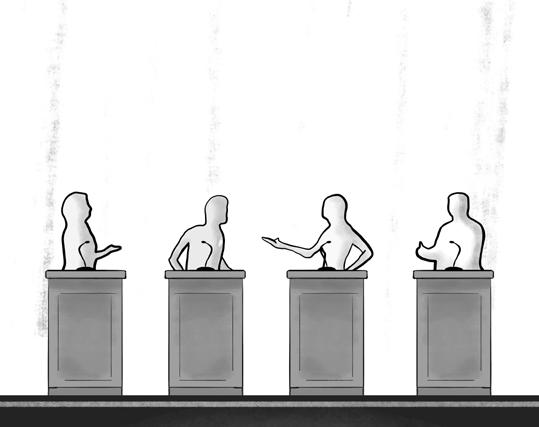
Thursday, March 2 from 12 p.m. to 2 p.m.
Debate 3 (Community Representative Candidates):
Friday, March 3 from 12 p.m. to 3 p.m.
Community Representative Candidates
Black students’representative
Anita Ayame
Zima Ndukwe
2SLGBTQIA+ representative
Alex Rana
International students’ representative
Naufil Ahmed Khan
Andrea Nguyen
Zeeshan Nisar
Dhruvi Shah
Racialized students’ representative
Allisther De Castro
Sofreen Sandhu
Indigenous students’ representative
Ishkode Catcheway
Women’s community representative
Witta Irumva
Accessibility community representative
Caleigh Guillou
Debate info
The debates will take place in the engineering atrium.
The forums will be panel-style, and each candidate will have the opportunity to answer pre-determined questions related to the position they are running for.
Vol. 109, No. 23 S2
Roleen Alarab, a third-year student pursuing a double major in biological sciences and psychology, has served as co-president of the University of Manitoba Working for Inclusivity in Chemical Sciences (UMWIC) group, sometimes working alongside UMSU in this role.
She said that she has undertaken over 600 hours of volunteer work within her community in the past three years, including with the Manitoba Lung Association and a non-profit organization that welcomes refugees to Canada.
She wants to become UMSU president to create a space where all students can feel safe to express themselves.
“We have many diverse intelligent students and I think it is important that the culture is acknowledged,” she said. “This will make for a more inclusive student body.”
Alarab’s priorities if elected will include helping students to make their voices heard, which she called “the first major step to improving our school.”
“So many students hold back from asking questions or reaching out for help, or trying to be involved in the university’s community,” she explained.
She also wants to advocate for students’ mental health and maintain constant communication between students and UMSU. She hopes to emphasize the importance of diversity at the U of M if she wins.
“There’s an abundance of nationalities within our community and yet we are lacking inclusivity,” she said. “I want to provide people with opportunities to try new things. I want to welcome them with open arms and inspire them to step out of their comfort zones.”
Alarab said she thinks that students need payment plans for tuition. She said that some students must postpone their degrees or drop out of their programs because they can’t afford to pay for a full semester of tuition all at once.
“I had to postpone my first semester of university because my immigration papers weren’t ready and the school didn’t help accommodate at all,” she said.
She expressed her opposition to lowering Canada Student Grants — which were doubled to a maximum of $6,000 in 2020 as a response to the COVID19 pandemic — to their pre-pandemic amounts, especially considering recent inflation. She also proposed fundraising money to assist struggling students with their tuition.
Alarab thinks that a “fresh set of eyes with a passion to change” will benefit UMSU and the student body.
“‘Refuse to be Silenced’ is my main slogan,” she said. “Together we will overcome, I am nothing without the students.”
Tracy Karuhogo
Tracy Karuhogo is a fourth-year student majoring in psychology with a minor in women’s and gender studies.
An international student from Uganda, Karuhogo has served on UMSU’s board of directors for the past two years, first as women’s community representative and currently as vice-president student life. She thinks this inside knowledge and experience makes her perfectly suited for the UMSU president position.

She wants to be president because she is “passionate about advocating for students.”
“After working as vice-president student life, I realized there is more work to be done to make the experience of my fellow students in post-secondary education better and beneficial,” she explained.
Her priorities include “fostering community through equity, diversity and inclusion initiatives,” broadening engagement with students and making services more accessible to those at U of M.
She highlighted the challenges that many face in accessing mental health support both on and off-campus.
“There is also a huge issue of affordable post-secondary education,” she said. “For example, the rising cost of tuition.”
She pointed to the high cost of textbooks and the potential cuts to Canada Student Grants as issues to address, and said she will advocate for international students’ free provincial health care to be reinstated.
Karuhogo outlined several ideas to save students money or assist them financially, including establishing a financial resources web page on the UMSU website with links to available scholarships, grants and bursaries.
Additionally, she said that she plans to introduce Businesses by Students Week, “where all students at the University with businesses are spotlighted on our socials and get a chance to table in University Centre in order to increase their customer base.”
She also supports more funding for the food bank, as inflation has increased the cost of food items, which in turn has reduced the amount of items that can be bought for students.
“Student leaders before me have advocated and worked to get us to this point and I also want to do my part to make my community better,” she said.
Justin Langan
Justin Langan is a third-year political studies student who has served as co-president of the University of Manitoba Indigenous Students’ Association and the Métis University Students’ Association.
He is also a representative on the Canadian International Council and is an activist for student rights, mental health, environmentalism and Indige-

nous prosperity. Last year, he worked with the Canadian Federation of Students’ Manitoba branch as one of the co-commissioners of the circle of First Nations, Métis and Inuit students.
He is running because he thinks that the student body consistently feels “unrepresented and underappreciated by the current union and has for years.”
“It’s time to change what UMSU represents and its relationships by re-establishing the core principles of transparency and accountability by which it was founded and by putting students first.”
Langan said that the “bedrock” of his priorities is rebuilding UMSU’s relationship with the Canadian Federation of Students and taking advantage of the benefits offered by federation membership. He also wants to restore students’ trust in the union and renewing campus life.
Langan hopes to honour the union’s commitment to working on behalf of the student body.
“I plan to implement a campus reconstruction plan that includes transportation alternatives, safe and available spaces, on-site engagement, winter events and tunnel renovations,” he said.
Langan hopes to also work alongside the Canadian Federation of Students in order to pressure the Manitoba government to reinstate international students’ health care.
“Students need more than a hardship fund; they need steady employment and leaders to fight against price gouging and tuition hikes,” he said. “I will re-evaluate UMSU businesses and work with them to offer better pricing and opportunities for students.”
“It’s time to make opting out of the U-PASS easier for students and work with the university to examine and reduce current fees, which include parking.”
Victoria Romero
Victoria Romero is a third-year political studies and history student currently serving as UMSU’s vice-president advocacy and as chair of the Manitoba Alliance of Post-Secondary Students.

Romero also sits on the national youth advisory board for Action Canada, an organization that bills itself as “Planned Parenthood Canada.” She believes her past experience with UMSU makes her a good candidate for president.
Cont’d p. S8 / Presidential >

UMSU Presidential Candidates
S3
Roleen Alarab
March 1, 2023
1. Roleen Alarab, photo by Ebunoluwa Akinbo
2. Tracy Karuhogo, photo provided
3. Justin Langan, photo by Ebunoluwa Akinbo
1 2 3 4
4. Victoria Romero, photo by Ebunoluwa Akinbo
Candidates
UMSU Executive
Vice-president student life
Christine Yasay
Christine Yasay is a fourth-year student pursuing a criminology honours degree with a minor in women’s and gender studies. She has served as the women’s representative for both UMSU and the Arts Student Body Council (ASBC) for the past year.
She has also served as a co-president of the Women’s Centre, social programmer for ASBC, director of internal relations for the University of Manitoba’s Sociology and Criminology Association of Students and as a member of the University of Manitoba Consciousness-Raising Association of Feminists. Additionally, Yasay has worked at the Academic Learning Centre as a program assistant and writing tutor for the past two years.
Yasay hopes to help increase student safety on campus by ensuring that proper safety measures are implemented, fostering a culture of mandatory consent and expanding Bringing in the Bystander workshops from student clubs, councils and associations to also include UMSU executives. According to Yasay, there has been a rise in sexual violence on campus since the return of in-person classes.
“I would really like to make sure that everything that can possibly be done to prevent sexual violence so that our students can feel safe is being put into action,” she said.
Combatting discrimination and racism on campus is another one of Yasay’s priorities if elected, and she aims to ensure that marginalized students feel safe and valued during their time at the university. She also wants to ease students’ financial burdens and reduce student poverty. To do this, she plans to increase the number of scholarships and bursaries for UMSU members, raise awareness regarding the UMSU hardship fund and UM food bank, provide additional holiday hampers for non-western holidays and ensure the availability of free menstrual products at the university’s campuses.
“In the last few years, we have been faced with a lot of challenges and adversity, and it’s important to me that students feel like they are getting the most out of their university experience, that they feel seen, heard and valued in the broader university community,” she said.
Yasay is running unopposed.
Vice-president advocacy
Ivan Nuñez Gamez
Ivan Nuñez Gamez, former comment editor at the Manitoban, is a third-year political studies and economics student who is currently serving as UMSU’s governance committee chairperson.
He is also the ASBC racialized students’ representative, vice-president advocacy for the University of Manitoba International Students’ Organization and a founder of the University of Manitoba Latinx-Hispanic Student Association.
Nuñez Gamez said that during his time as governance committee chairperson, he has helped make changes within UMSU despite administrative obstacles, citing the creation of an UMSU racialized community representative position as an example. He hopes that by running for this position, he can advocate for and inspire
students, especially those with racialized identities.
“Thousands of students come in with big dreams and aspirations and it’s devastating to see how they’re forced to renounce [their dreams] due to tuition increments or lack of support,” Nuñez Gamez said.
“I want to run not only to advocate for students, but also with them.”
Nuñez Gamez outlined an advocacy plan that focuses on collaborative governance and community-based advocacy. He plans to oppose a performance-based funding model for Manitoba post-secondary institutions, lobby for a tuition freeze, advocate for more accessible education delivery methods and address issues faced by international students such as health care access.
“Increasing security in public transportation, lack of grants and student aid and bias in the co-op program are just some areas that are yet to be explored in UMSU advocacy efforts and that I plan to shine a light on,” he said.
He also plans to improve collaborative governance by creating multiple student-led advisory boards within UMSU.
Nuñez Gamez said that he favours an education model that prioritizes students. He proposes that a third of a student’s final grade should be given before the voluntary withdrawal date, and that the school should implement a “life happens” policy that grants students one no-questions-asked 48-hour extension per course.
“When we mobilize all of our resources and unite student voices against the same force, we can bring effective change in a more efficient manner,” he said.
“That is what our union should be doing, and the only way to successfully achieve this is with the help of faculty associations and community centres.”
Liam Pittman
Liam Pittman is a fourth-year sociology major with a minor in psychology.
“I am running for this position because I believe in advocacy and the power of the student voice,” Pittman said.
Pittman said he decided to run because he can “understand the frustration that students have with UMSU and not feeling connected.” He aims to build connections and relationships with students in order to amplify their voices and implement change.
Pittman emphasized the significance of maintaining open communication between student executives and the students they represent. He stressed the importance of executives consistently and proactively engaging with students and student groups. That way, they can gain insight into their concerns and work with students.
“If elected, I will always make an effort to reach out to student groups and communities to better understand and advocate for the issues that matter to them, not the issues that only matter to me,” he said.
Pittman hopes to relieve some of the financial burdens that students may feel by advocating for free and open educational resources such as textbooks and by opposing tuition hikes and performance-based funding.
“Students now more than ever are experiencing immense financial strain,” Pittman said. “It is my goal to create and implement sustainable pol-
icies to help reduce some of that financial strain.”
He plans to work with provincial political parties to improve policies for students regarding health care, finances and employment. Pittman also wants to communicate more with the Bannatyne campus in order to address Bannatyne students’ issues, and he hopes to craft a more “survivor-compassionate” approach regarding sexual violence.
Pittman said that a background working in advocacy and with marginalized groups has given him experience that qualifies him for the role, and that through this experience, he has learned that it is best to amplify the voices and opinions of the people being served.
“I do not have all the answers, but I recognize that and will continue to consult and learn from communities and groups that have lived experiences,” he said.
“Whether working with community-led youth programs, medical charities, student associations or as an UMSU executive, I will continue to give the voice back to those who I am serving.”
Vice-president finance and operations
Peter Akiode
Peter Akiode is a second-year student pursuing a degree in human resource management.
Akiode previously served as a treasurer for his student community in high school and later began to work for Neo Financial, where he is currently employed. He said that in his position at the company, he helps to make the banking experience of individuals easier.
He explained that he wants to improve both the welfare and financial situation of students, especially international students and individuals who are in less privileged positions.
“In conjunction with the U of M management, donors and support organizations, my priorities [if] elected [are] to increase or improve on financial aids and awards to students,” he said.
To do this, he plans to expand the automatic student scholarships. He also hopes to improve the process for students who are accessing student loans.
He said that he plans to “work toward increasing the international student award scheme to benefit more international students, especially students from poor countries.”
Vaibhav Varma
Vaibhav Varma is a third-year political studies and history honours student. He has held multiple positions in student organizations on campus, including president of U of M’s Campus Conservatives, and has political experience at the municipal, provincial and federal levels.
He has worked as the UMSU board of directors chairperson, as a senator and director of academic programming on ASBC and as a fundraising co-ordinator and alumni relations co-ordinator for the Youth Parliament of Manitoba.
Varma explained that he is running for this position because of the lack of awareness that students have when it comes to paying their UMSU fees, and concerns he has over the union’s financial transparency.
Vol. 109, No. 23 S4
“It has always been an aspiration of mine to seek positions where I can push for meaningful change by acting on the interests of the voters I aim to serve,” Varma said.
He said that he has also noticed a lack of representation for the South Asian community within UMSU, especially considering the contributions that South Asian students make to the university.
He described his platform as being centred around increasing financial transparency and accountability, supporting diverse cultural organizations, faculty associations and student clubs and bridging the gap between the student union and the student body.

“Every student deserves to know the salaries of their UMSU executives,” he said.

“Every student deserves to have a readily available and comprehensive breakdown of their union fees. Every student deserves to feel that their union works for them, and their executives are available to listen and hear their concerns.”
Varma said that his past experience with UMSU and ASBC has given him knowledge of how UMSU and student organizations work.
“UMSU does not need a VP finance and operations that builds a firewall between students and their elected representatives,” he said.
“It is imperative that this role is filled by someone who doesn’t serve the benefits of the status quo, but rather the hard-working students of this university.”
Vice-president community engagement
Elishia Ratel
Elishia Ratel is the current vice-president community engagement and is running for re-election. She has also served as a senator and director of communications for the Faculty of Music Students’ Association.
“My experience with UMSU has allowed me to see the intricate inner workings of the union, how it currently serves students and how it could stand to serve them better,” she said.
Ratel is running for re-election because she wants “to bring more fun events and once-in-a-lifetime oppor-
tunities to our campus” and show students the benefits of engaging with campus life.
“With my experience in this role, I’m confident that the bar can be set even higher for what we can achieve, making it easier than ever to get involved on campus,” she said.
Some of Ratel’s main priorities include bringing fun events to campus, instituting new student discounts and perks and making more resources available for students. She hopes that more student discounts will “bring more value to student life.”
“I want to bring more student perks back to our community, such as more free breakfasts throughout the year and bringing back the pizza discount,” she said.
Ratel hopes to build upon relationships with the administration and community representatives in order to provide more supports to students.
“ This includes providing more equitable access to resources, opening up more funding for community initiatives and collaborating with groups to support their work,” she explained
“As someone who knows and experiences the value of community, I’m committed to building students up to ensure that they are receiving the full benefit from their community.”
Divya Sharma
Divya Sharma is pursuing a global political economy degree in the faculty of arts.

She has served in multiple positions at the university including as an UMSU representative for ASBC, director of administration for the University of Manitoba Global Political Economy Student Association and as a U of M senate committee appointee.


Sharma’s past experience on student councils has allowed her to hear students voice their concerns. She said that her community values and experience as an immigrant in Canada has helped to inform her ideals of giving back and serving the community, and that she is determined to bring these values to campus.
“My priorities will include creating an immersive experience for students through the promotion of diversity and school spirit,” Sharma said.
She said she wants to “create a col-
laborative approach” so that the union can partner with faculty associations and student groups on campus when planning events.
Sharma wants to enhance the university experience for students on campus through partnering with the Winnipeg Chamber of Commerce to organize on-campus networking events, maintaining an events calendar on the UMSU website and hosting large-scale events to promote school spirit and celebrate diversity.


Some of her past experiences in community engagement involve the public and non-profit sectors, government and student politics. In the past, Sharma has worked with numerous organizations to organize educational events for various communities. Currently, Sharma works at the Winnipeg Chamber of Commerce as the diversity, equity and inclusion officer.
“I also believe that the role of community engagement is heavily reliant on co-ordination, time and project management,” she said.
“During COVID-19 I had the opportunity to create a national care packages program to honour frontline workers, for which I was thankful to be recognized by the United Nations.”
UMSU Executive Candidates
1. Christine Yasay, photo provided
2. Ivan Nuñez Gamez, photo by Ebunoluwa Akinbo
3. Liam Pittman, photo provided
4. Peter Akiode, photo by Ebunoluwa Akinbo
5. Vaibhav Varma, photo provided
6. Divya Sharma, photo by Ebunoluwa Akinbo
7. Elishia Ratel, photo provided
March 1, 2023 S5 news@themanitoban.com 1 2 3 4 5 6 7
Communty Rep Candidates
Black Students’ Representative
Anita Ayame
Anita Ayame is a fourth-year double major in biological sciences and genetics minoring in microbiology, health sciences and psychology.
She is currently the Black students’ representative on UMSU and has also served as the women’s representative on the University of Manitoba Black Students’ Union (UMBSU).
“I am motivated to run for this position because I believe that we need an advocate who is committed to addressing the unique challenges and issues faced by Black students, and who can work with school administration and other stakeholders to promote diversity, equity and inclusion,” she said.
She hopes to work with the administration to identify barriers that Black students may face regarding academic success and to promote equity, diversity and inclusion at the U of M.
“This may involve organizing cultural events, promoting diversity education, intercultural dialogue and exchange [as well as] more ethnic food options,” she said.
She also hopes to address mental health issues faced by Black students and ensure that financial aid, scholarships, job placements and internships are more accessible for them.
“Overall, my platform is focused on promoting the academic success, diversity, equity and mental health of Black students,” she said.
“I believe that by addressing these issues, we can create a more inclusive and equitable school community that supports the success and well-being of all students.”
Zima Ndukwe
Zima Ndukwe is a second-year economics student and the vice-president finance of UMBSU.
Ndukwe, who lived in Nigeria before moving to Canada six years ago, said that her role on UMBSU gives her a “deeper understanding of the intricacies of dealing with UMSU and the university system in general as a Black student.”
She said that she wants to see Black people “thrive and feel included” at the U of M. Ndukwe explained that her experience on UMBSU showed her the financial barriers that Black student clubs face when trying to create events on campus, and she said that making funding available for Black clubs is one of her biggest priorities.
“As a Black student, I know that these events promote a sense of belonging and community,” Ndukwe said.
One of the other main issues on Ndukwe’s agenda is fees for international students.
“As a significant portion of the Black students on our campus are also international students, it is understood that the university’s ever-increasing fees for international students also negatively impact the Black community here at the University of Manitoba,” she said.
Ndukwe also wants to give Black students “an active role in their education.”
“For several reasons, many Black students shy away from speaking up about their ideas and the issues they face,” she said.
“I really want to create a safe space for those students to come forward and be able to express what’s on their mind knowing that they will be advocated for.”
2SLGBTQIA+ students’ representative
Alex Rana
Alex Rana, a fourth-year student pursuing a double honours in English and linguistics, is currently the 2SLGBTQIA+ students’ representative for UMSU and is running unopposed.
He is also the co-president of the Rainbow Pride Centre and the Arts Student Body Council’s (ASBC) director of community engagement, and is running to continue to build on his previous work in the same UMSU community role.
“Although the 2SLGBTQIA+ community and the Rainbow Pride Centre have a long history of being active on campus, it is important that we continue to have specific community representation on the UMSU board of directors and are able to keep the [Rainbow Pride Centre] running effectively to provide a space for students in the community,” he said.
Raising awareness regarding the Rainbow Pride Centre is one of Rana’s main priorities.
“It can be very hard to find out spaces like this exist on campus unless students happen to hear from others, walk by when we’re tabling or see one of our posters,” he said.
He also wants to increase communication with the Bannatyne campus to meet the needs of 2SLGBTQIA+ students there.
Ensuring accessible washrooms for all students is another key issue for Rana, who wants to make sure that they are easier to find and that students don’t have to leave a building to find a washroom that works for them.
“To better address this next year, I plan to connect with those currently involved in overseeing this area to discuss the plan for creating new gender-neutral bathrooms and stress the importance of resources being directed toward this,” he said.
International students’ representative
Zeeshan Nisar
Zeeshan Nisar did not respond to multiple requests for written answers to questions before time of publication. They are running for international students’ representative.
Dhruvi Shah
Dhruvi Shah did not respond to multiple requests for written answers to questions before time of publication. They are running for international students’ representative.
Andrea Nguyen
Andrea Nguyen is a third-year data science student who has served as the Orientation Welcome Leader for fall 2021 and 2022 and the vice-president of membership experience at the UMSU Women’s Centre.
She is also the international students’ representative for the University of Manitoba Science Students’ Association, and believes that these roles along with her experience as an international student from Vietnam give her the necessary skills for this position.
“These amazing opportunities have helped me to understand the concerns that first-year students have and what support they need, improve my active listening and teamwork skills and know more different resources that the
university provides for students,” she said.
She hopes to raise awareness regarding the supports available to international students on campus.
“Upper-level international students like myself struggled to find internships and decide what job opportunities can lead us with our current degree,” she said.
She is also concerned about the difficulty many international students face navigating student visa systems, and highlighted the sense of isolation and alienation some international students may feel in a new country.
“Some want to make new friends, but they are hesitant to talk first or afraid that others do not understand,” she explained.
“With all of those concerns, I want to proactively approach international students to support them with different resources that the university provides, and advocate for their needs.”
Naufil Ahmed Khan
A second-year student, Naufil Ahmed Khan has served this past year as the vice-president internal for the University of Manitoba Undergraduate Political Studies Students’ Association.
Khan, an international student from Pakistan, has also volunteered or worked with a number of other community-specific organizations.
“Once elected as the international student representative, I believe that I can make a positive impact in all international communities by serving as a liaison between students, their needs and the university,” he said.
One of Khan’s central issues is mental health support for international students, who he said face additional struggles so far from home.
“A lot of these students are unaware of the resources that are available or are afraid to talk to someone,” he said. ”It is critical that I provide support and resources to international students to help them tackle this issue.”
He also highlighted health care for international students as a key part of his platform.
“International students already pay abnormally high tuition fees and yet are forced to pay for private health care,” he said. “This issue has been taken up before and previous governments have advocated for this. My aim is to continue this and keep advocating for this until we get results.”
Racialized students’ representative
Allisther De Castro
Third-year political studies student Allisther De Castro is running for the newly-instated position of racialized students’ representative. She is currently an ASBC Racialized Student Caucus member and a University of Manitoba Filipino Students’ Association (UMFSA) member.
During De Castro’s time serving as an UMSU director for the University 1 Student Council, she came to the conclusion that UMSU directors and executives were not making enough of an effort to include racialized communities.
“I am running for this position because progress needs to be made and racial awareness needs to be talked about,” she said.
She hopes to serve the community with what she calls the “4 Rs” — representation in student faculty associ-
Vol. 109, No. 23 S6
UMSU
ations, reporting BIPOC discrimination, raising awareness and providing a racialized community space.
“I would advocate having the position of racialized representative open to all associations to give BIPOC students an opportunity to represent their communities,” she said.

De Castro seeks to establish better methods for students to report discrimination, and wants to implement required racial awareness and sensitivity training for groups on campus in order to address racial discrimination.
“With the policies that I am aiming to implement supported by my leadership and interpersonal experience, I believe that I am capable and competent to advocate for the racialized community,” she said.
Sofreen Sandhu

Sofreen Sandhu is a second-year nursing student. She believes that as an international student of colour, she has first-hand experience dealing with the challenges faced by marginalized people on campus.

“I have a strong track record of pushing for diversity and inclusion through my roles on campus in several student organizations,” Sandhu said.
She pointed to the different events and campaigns she has organized to “promote diversity and raise awareness about concerns of social justice.”
Sandhu is running to challenge racism and discrimination on campus and to provide more representation for racialized students.


“Representation matters, and it is essential that the perspectives and experiences of racialized students are included in decision-making processes,” she said.
“This includes advocating for more
racialized individuals to be hired for faculty and staff positions, as well as promoting opportunities for students to participate in leadership roles.”
Sandhu also hopes to provide more mental health supports for racialized students and promote anti-racist ideas throughout campus.
“This means promoting critical dialogue, education and awareness about racism and discrimination, and working toward creating a safe and inclusive environment for all students,” she said.
Indigenous students’ representative
Ishkode Catcheway
Ishkode Catcheway is a fourth-year student with a major in heath studies and a minor in Indigenous languages. She is currently UMSU’s Indigenous students’ representative and is running for re-election unopposed.


Catcheway has held the position of communications co-ordinator with the University of Manitoba Indigenous Students’ Association (UMISA) for two years and is involved in programs such as the Indigenous Circle of Empowerment (ICE) and Neechiwaken Indigenous Peer Mentor Program.
Catcheway is running for re-election because there is more that she
11.
12.
wants to do for the Indigenous community on campus.
She hopes to finish her work in establishing a community space for Indigenous students on campus if elected and would also like to continue the Indigenous Student Art Program in the coming year.
“I want to be able to provide safe spaces for Indigenous students to study or hang out, as well as be an advocate for them,” she said.
She believes that there has been a lack of communication and collaboration between past UMSU executives and UMISA.

“I hope to continue working on this if elected to be able to finally have a good relationship between UMSU and the Indigenous community on campus,” she said.
Catcheway hopes to give a voice to the Indigenous community on campus and wants to make sure that Indigenous voices are heard.
Women’s community representative
Witta Irumva
Witta Irumva is a third-year genetics honours student. She is the vice-president of social media and marketing with the UMSU Women’s Centre and works on the social media team for the Black Student Empowerment Society.



Cont’d p. S8 / Community >
UMSU Community Rep Candidates

March 1, 2023 S7
1. Anita Ayame, photo provided
2. Zima Ndukwe, photo by Ebunoluwa Akinbo
3. Alex Rana, photo provided
4. Zeeshan Nisar, photo by Ebunoluwa Akinbo
5. Dhruvi Shah photo by Ebunoluwa Akinbo
5 6 7 8 9 10 11 12
6. Andrea Nguyen, photo by Ebunoluwa Akinbo
7. Naufil Ahmed Khan photo by Ebunoluwa Akinbo
8. Allisther De Castro, photo provided
9. Sofreen Sandhu, photo provided
10. Ishkode Catcheway photo provided
Witta Irumva, photo provided
4 1 2 3
Caleigh Guillou, photo provided
Cont’d
< Presidential candidates cont’d from p. S3
She wants to become president to create a supportive university environment for all students where they have access to the resources they need.
“UMSU must hold the UM accountable to this responsibility, and as president I will ensure that this is done not only in my role, but by empowering and providing resources to groups on campus so they can do the same,” she said.
Her priorities include breaking down economic, social and accessibility barriers to education, building rapport with students in order to better address their needs, striving to host fun and inclusive events and fulfilling UMSU’s mandate to represent students.
“A strong and organized student union is the key to creating a university community that puts people over profit — UMSU has the duty to ensure student concerns come first,” she said.
With rising cost of living and tuition, Romero said that she will advocate for free and accessible learning materials, such as open educational resources.
“The expansion of [open education resources] would mean more students are able to attend class as financial barriers are removed,” she explained. “Nobody should ever have to make the decision to choose between paying for food or paying for textbooks.”
Romero also hopes to support harm reduction initiatives, and aims to cultivate stronger relationships between UMSU and the three levels of government in order to facilitate more advocacy on issues such as transportation and safety.
Romero hopes to help students financially by opposing organizations that attempt to put profit over student needs, fighting for increased hardship funding, resisting tuition fee increases and advocating for the reinstatement of free health care for international students.
“Complacency breeds a decline in access to affordable educational resources (tuition, textbooks, tutoring) and furthers the narrative that univer-
sities are able to exist for profit,” she said.
Romero thinks that her time as vice-president advocacy has demonstrated her ability to advocate for students despite adversity.
“My advocacy does not end when others say it is unattainable, but when I have accomplished the goals I have set out to achieve,” she said.
news@themanitoban.com
< Community rep candidates cont’d from p. S7
She is running for the position unopposed.
She believes that her involvement in extracurricular activities on campus has sharpened her organizational and management skills, and that her work with the Women’s Centre has allowed her to build connections with the community and contribute to change on campus.
Irumva said that her experiences have taught her the importance of providing sufficient supports and resources to those who need them.
She highlighted the importance of creating a safe space for the women’s community on campus where individuals are guaranteed inclusion and accessibility.
“I want to use my position to raise their voices on matters impacting the community and help realize projects that benefit women-identifying students,” she stated.
Irumva wants to amplify three important issues — awareness regarding sexual violence, inclusion in the community and distribution of products and resources.
“I want to connect students with the resources and assistance they require regarding campus or off-campus matters,” she said. “I also want to work to dismantle the most accepted depiction of a woman and promote representation that is accurate to the individuals that encompass our community.”
Accessibility community representative
Caleigh Guillou
Caleigh Guillou is a second-year psychology student with a double minor in political studies and health sciences. She is currently serving her second term as UMSU’s accessibility community representative and is running for re-election unopposed.
Guillou is also this year’s co-chair of the Bisons Walk-a-thon for Childhood Cancer and a consent culture workshop facilitator with Justice for Women.
“Accessibility shortfalls present a multi-tiered challenge to our community,” she said.
“I believe my greatest strength in this role is my ability to understand the intersectionality of local, provincial and national policies as they relate to University of Manitoba students living with disabilities and addressing the barriers in their daily lives.”
Guillou is running for re-election because she is passionate about advocating for the community on campus.
“Regardless of ability, each of us deserves equitable access to whatever we want our unique university experience to look like,” she said.
“ With the understanding that accessibility is not one-size-fits-all, I will strive to continue serving my community while highlighting the importance of valuing and meeting the unique individual needs of every disabled student.”
Her plans for next year are focused on facilitating access to academic accommodations for survivors of sexual violence, ensuring that students have a safe way to dispose of sharps medical waste, informing students of internal and external disability rights and continuing to implement more accessible information technology at the university.
Voting will be held online from March 9 to March 10 at
news@themanitoban.com
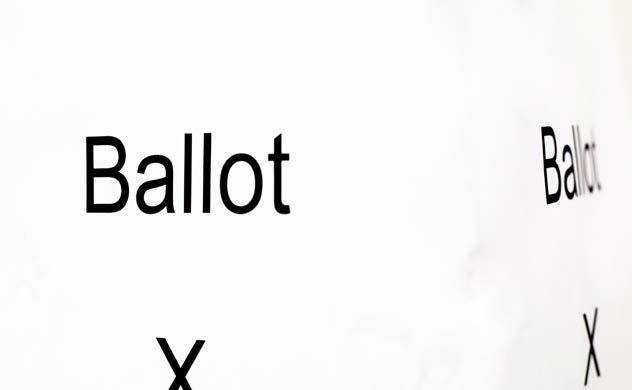
2023
UMSU Candidates
Vol. 109, No. 23 S8
umsu.simplyvoting.com
From our archives
EARLY 20TH CENTURY MODELS OF THE SOLAR SYSTEM IMAGINED THAT PLANETS CIRCLED THE SUN LIKE ELECTRONS IN AN ATOM. WE NOW KNOW PLANETS HAVE NO PRECISE LOCATION, BUT INSTEAD OCCUPY PROBABILISTIC ORBITALS...
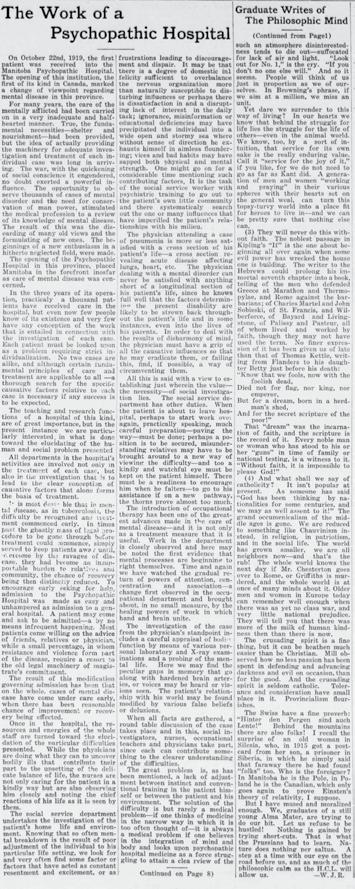

THE EARTH IS, ON AVERAGE, LOCATED IN THE HABITABLE ZONE, BUT AT ANY GIVEN TIME IT HAS A CERTAIN PROBABILITY OF BEING OUTSIDE IT, WHICH IS WHY LIFE EXISTS ON EARTH BUT IS MORTAL.
phdcomics.com
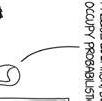

To complete Sudoku, fill the board by entering numbers 1 to 9 such that each row, column and 3x3 box contains every number uniquely
In Hidato, fill the board by continuing the chain of numbers from 1 to 100 moving any direction or diagonally to the next number.
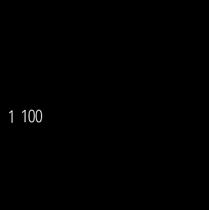
rows and columns are divided by black . These need to be filled in with numbers that is a set of numbers with no gaps but can be in any order, eg [4,2,3,5]. Clues in black cells remove that number as an option in that row and column, and are not part of any straight. Glance at the solution to



How to beat Str8ts –
Like Sudoku, no single number can repeat in any row or column. But... rows and columns are divided by black squares into compartments. These need to be filled in with numbers that complete a ‘straight’. A straight is a set of numbers with no gaps but can be in any order, eg [4,2,3,5]. Clues in black cells remove that number as an option in that row and column, and are not part of any straight. Glance at the solution to see how ‘straights’ are formed.
Puzzle
To complete Sudoku, fill the board by entering numbers 1 to 9 such that each row, column and 3x3 box contains every number uniquely.
For many strategies, hints and tips, visit www.sudokuwiki.org
If you like Str8ts check out our books, iPhone/iPad Apps and much more on our store. The solutions will be published here in the next issue.
In Straits, like Sudoku, no single number can repeat in any row or column. But rows and columns are divided by black squares into compartments. These need to be filled in with numbers that complete a “straight.” A straight is a set of numbers with no gaps but can be in any order, eg [4,2,3,5]. Clues in black cells remove that number as an option in that row and column and are not part of any straight. Glance at the solution to see how “straights” are formed.

To complete Sudoku, fill the board by entering numbers 1 to 9 such that each row, column and 3x3 box contains every number uniquely.
For many strategies, hints and tips, visit www.sudokuwiki.org
If you like Str8ts check out our books, iPhone/iPad Apps and much more on our store. The
the next issue.
How
Like Sudoku, no single number can repeat in any row or column. But... rows and columns are divided by black squares into compartments. These need to be filled in with numbers that complete a ‘straight’. A straight is a set of numbers with no gaps but can be in any order, eg [4,2,3,5]. Clues in black cells remove that number as an option in that row and column, and are not part of any straight. Glance at the solution to see how ‘straights’ are formed.
21 graphics@themanitoban.com March 1, 2023 Diversions 4738 7654 51 193685 43 2179 3159
2023 Syndicated Puzzles 472386915 359412876 861579432 798254361 125863749 634197258 543921687 916738524 287645193
©
SUDOKU
No. 630 Tough Previous solution - Medium
Hidato xkcd.com
Answer to last issue’s
ago 861 96 1 2 736 4 6 3548 89 6 9 8 2 1
2023 Syndicated Puzzles 5 21 3 STR8TS No. 630 Easy 985423 892354 671243 85634 745639218 34987 567489 329867 218756 1 5 7 2 3
100 years
©
to beat Str8ts –
Previous solution - Medium SUDOKU The solutions You can find more help, tips and hints at www.str8ts.com No. 630 861 96 1 2 736 4 6 548 89 9 8 2 1 © 2023 Syndicated Puzzles 4738 7654 51 193685 43 2179 3159 © 2023 Syndicated Puzzles 472386915 359412876 861579432 798254361 125863749 634197258 543921687 916738524 287645193 STR8TS 630 Easy 985423 892354 671243 85634 745639218 34987 567489 329867 218756 1 5 7 2 3
Previous solution - Medium SUDOKU
can
more help, tips and hints at www.str8ts.com No. 630 Tough Previous solution - Medium Answer to last issue’s Sudoku 861 96 736 4 6 6 9 8 2Puzzles STR8TS No. 630 Easy 985423 892354 671243 85634 745639218 34987 567489 329867 218756 1 5 7 2 3 How to beat Str8ts –Like Sudoku, no single number can repeat in any row or column. But... rows and columns are divided by black squares into compartments. These need to be filled in with numbers that complete a ‘straight’. A straight is a set Previous solution - Medium Answer to last issue’s Straights
solutions will be published here in
find
Sudoku
Puzzle by Syndicated Puzzles
Hidato
Puzzle by M.J.D. Doering
Straights
by Syndicated Puzzles
Horoscopes for the week of March 1
Zodiac tips for surviving life at the U of M
Damien Davis, staff ARIES
Your tarot card for the week is the Hermit. Have you spread yourself too thin? Made sacrifices for people or situations that ended up not benefiting you in any way? In biblical stories and mythology, sheep are often sacrificial in nature, born to bleed for others. You don’t have to subscribe to that. It’s time to tear off your horns and return to your inner world. This card tells you that once you’ve become the master of your own fate, those who don’t have your best interests at heart will disappear.
TAURUS
Your tarot card for the week is the High Priestess. What did being stubborn get you last month? Was it worth the fallout that came with it? This card asks you to look into the realm of intuition and empathy. The answers you seek are inside, but you’ve got no way to get them if you don’t take a deep breath before you act. You can rule a kingdom without putting fear into the heart of its citizens.
GEMINI












Your tarot card for the week is Judgement. Take the hand of your other self and know that you are close to the end of your self-discovery journey. You’ve learned from your past mistakes; you’ve been taking steps into healing the cycles and you’ve started to treat yourself more tenderly than before. This card is telling you that the deep wounds are ready to fully heal, but it’s up to you to finally understand that you don’t need them anymore. Take your hair down, smile at carnations and know that you’ve done what you thought could never be done.
’Toban Tips Partner pulling away
Dear Toby, I feel that my significant other has been pulling away from me. They don’t return my calls, they prioritize their friends over me and they don’t even say they love me anymore. I’m desperate to win back their affections. I’ve even taken to performing witchcraft that I’ve found online in an attempt to win them over, to no avail. What should I do? I can’t lose them.
Thank you, Worried partner
CANCER
Your tarot card for the week is the Moon. With the moon in Cancer at a waxing gibbous, this card symbolizes the need for a spiritual feast to cure the famine that has conquered your heart. You may be feeling fulfilled and content in so many areas, but not as enriched in the realm of faith. The moon is in your favour, so honour your family traditions and create rituals and practices that nurture the soul as well as the body. Consider reaching out to a mentor.
LEO
Your card for the week is Temperance. The old ways are not working, so it’s time to adapt. Now is the time to take the middle ground, consider all perspectives and remain calm. You’ve survived far worse than this and you’re close to the school year being over. A level-headed approach is the best course of action. Remember what it was all for and know that your career is just around the corner. Some day when you’re older you’ll be grateful for your ability to persevere during this time.
VIRGO
Your tarot card for the week is the Sun reversed. It’s time to heal your inner child. It’s tiresome work and it might seem pointless, but when was the last time you saw the sun and let it comfort you? You may be feeling like you’re stuck in a cycle within your education, your studies or your home life. Take this time to do little things to uplift your mood. Watch your favourite childhood films or buy yourself a treat on campus just because, no strings attached. This card wants you to know that the gloom is only temporary. You’re incredibly strong and you will climb out of what plagues you, it’s just a matter of getting there.
Dear Worried partner, I am sorry to hear that you are experiencing this and can imagine that it would be very difficult, but don’t panic. If a partner is pulling away, it might have more to do with them than it does with you or the relationship. So, don’t take it to heart.
Open communication is the best way to handle this.
Find a time to have an honest sit-down conversation with your partner about your relationship. Use “I” statements
LIBRA
Your tarot card for the week is the Hanged Man. It’s time to surrender, put everything down and prepare yourself for the next step of your goals, or else the stars will do it for you and they do not operate on what’s most convenient for us. If you find yourself at an unexpected halt in progress, don’t assume that you can push through it with positive results. It’s time to sit back and recalibrate your methods. Take time away from your usual rituals and readjust the scales. Readjust the outcomes.
SCORPIO
Your tarot card for the week is Justice. Your addiction to self-deprecation and martyrdom will be your undoing if you don’t nip it in the bud now. It’s important to you to always know the truth, to act within the truth and to always stand by your actions. But when do you get to rest? When do you get to sit down away from the pressure of your expectations and just simply be? Don’t confuse accountability with self-hatred. Remember what you used to aim for prior to all the hang ups: benevolence.
SAGITTARIUS
Your tarot card for the week is the Wheel of Fortune. You have been tossed into the wheel once again, and this has caused you to feel the fatigue of your fate changing, interests shifting and hardships piling on top of you. This card symbolizes the knowledge in those small moments of happiness you experience. The pride in your work, the assurance in your voice — it’s all to be cherished. The wheel turns and it won’t always turn into sorrow, so have faith that even if you’re at a turning point in your life, new experiences are coming with the future. Put on your blindfold and take aim. Know that your heart is true and the universe has
to express how you feel, why you feel the way you do, your overall concerns and the emotional needs that you want fulfilled moving forward.
Be open minded, and be ready to talk and listen. It’s possible that your partner isn’t aware of how they are making you feel! Be patient and give your partner the time and space they need to process should they need some alone time.
Above all else, you need to prioritize yourself and your
not forgotten that.
CAPRICORN
Your tarot card for the week is the Lovers. This card asks you to stand by your values and beliefs, even if they’re still in the making. The act of staying true to who you are is noble and embodies someone who acts with love for themselves and the people around them. It’s a season of making choices for you, but know that you can’t make them out of fear or guilt. They have to be made out of love. March will bring forth a version of yourself that you didn’t even realize existed, as long as you let them through the door.
AQUARIUS
Your tarot card for the week is the Emperor reversed. How much power and control have you let yourself misuse? It’s easy to be blinded by authority, confidence and ego, but who do we hurt when we decide everyone else simply doesn’t know what we know? It’s time to stand up to your own authority, overthrow the throne and remember what it was like when you first started out here. Pay attention to staying positive, not just for others but for yourself. The efforts you make will bring you to a successful end of March.
PISCES
Your tarot card is Strength reversed. Setbacks happen, it’s something out of your control. It’s understandable to feel discouraged and be annoyed with yourself, but what does that do for you? Does punishing yourself for something that was never your fault help you to prevent it in the future, or is this the only way you know how to cope? This card asks you to start from the beginning and work your confidence back up. You will feel what you felt before in March, don’t worry.
well-being. If you feel that your needs are still not being met even after communicating them to your partner, you need to consider whether this is the right relationship for you.
It might be hard, but I believe in you and I know you can overcome this!
Best of luck, Toby the Bison
To ask Toby a question, email comment@themanitoban.com

22 graphics@themanitoban.com Vol. 109, No. 23 Diversions
14
In the memory of MMIWG2S






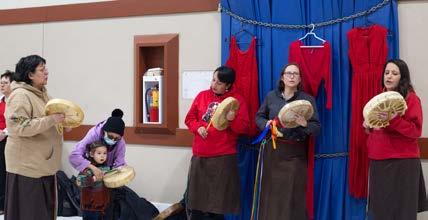 photos: Ebunoluwa Akinbo, staff
photos: Ebunoluwa Akinbo, staff
24 features@themanitoban.com Vol. 109, No. 23 Features
16
The annual women’s march in Manitoba for Missing and Murdered Indigenous Women, Girls and Two-Spirit individuals took place on Feb. 14.
Education with a destination
Your ticket to a career with endless variety.
The program accelerated my career by at least ve years. I love the variety, I love the diversity and I love the people.”
AN
INITIATIVE
BY:
Accelerate your career when you join a tourism education program. Browse available programs at travelmanitoba.com/tourism-education
 SYLVIE FOIDART | TOURISM COORDINATOR ECONOMIC DEVELOPMENT COUNCIL FOR MANITOBA BILINGUAL MUNICIPALITIES (CDEM) GRADUATE OF TOURISM MANAGEMENT ST. BONIFACE UNIVERSITY
SYLVIE FOIDART | TOURISM COORDINATOR ECONOMIC DEVELOPMENT COUNCIL FOR MANITOBA BILINGUAL MUNICIPALITIES (CDEM) GRADUATE OF TOURISM MANAGEMENT ST. BONIFACE UNIVERSITY
Festival du Voyageur as a first-timer
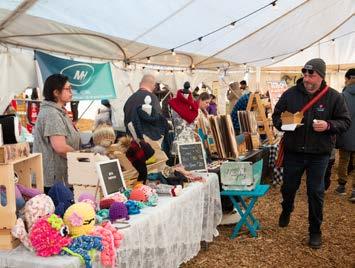
An experience of a communal mix of Canadian culture
Damien Davis, staff
Despite living in Winnipeg for nearly a decade, I had never attended Festival du Voyageur before this year, even with the high acclaim it has received from all my friends who were born and raised here.
However, this year I made the journey to St. Boniface and into Whittier Park for Winnipeg’s famous francophone festival celebrating Métis culture and what I found was more than I could ever anticipate.
Festival du Voyageur welcomes over 90,000 people annually, and even though I attended on a Thursday rather than during a bustling weekend there were plenty of attendees filling up the park.
The first things that caught my eye as an attendee — other than the smell of smoke and the beautiful echoes of fiddling from various tents — were the snow sculptures.
Festival’s International Snow Sculpture Symposium was an incredible sight to pass by exiting the Tente Forest, with many large works from several artists. The snow sculptures were directly across from Fort Gibraltar, a time capsule of the voyageur era with staff in historical dress.

Inside the fort you could find several cabins with different educational topics such as l’atelier, which focused on how carving and canoe making was done at the time.
Attendees could also climb a staircase leading up to the fort’s rampart, which provided a view of the entire area.
the cold, the restaurant was alive with fiddling, giantsized Jenga and a diverse, mouth-watering menu ranging from Rubaboo stew to traditional tourtière.
I personally ordered bannock with whipped butter and a very large coffee to prepare myself for the return to the cold — though Festival’s several firepits and warming areas made it a less insidious enemy.
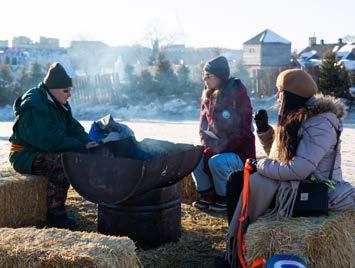
Winter Stories with Elders Barbara Nepinak and Winston Wuttunee. Inside you could sit down, get warm and hear stories in both Cree and Anishinaabemowin from two fantastic storytellers.
and a Festival du Voyageur button from La Boutique du Voyageur.
Just like that, my journey was over, and I left the park with the strong scent of smoke in my hair and a sense of community that I hadn’t had prior. It was incredible to witness such a large display of not only francophone culture but of Indigenous art, traditions, culture and languages as well.
Festival du Voyageur is a mosaic of francophone, Métis and Indigenous culture beautifully woven into one event
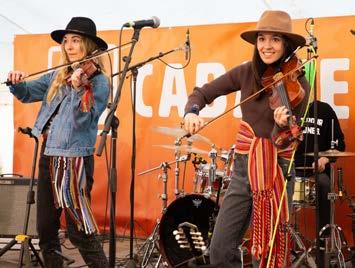
One of my favorite parts about Fort Gibraltar, however, was the restaurant Brasserie du Bourgeois. Safe from
One of these fire pits was the Infinity Fire, found in the heart of the park in the shape of the infinity symbol to represent the eternal resiliency of the Métis in Manitoba.
Not far from the Infinity Fire was a teepee featuring
Once you’d had your fill of winter stories, you could make your way to any tent and there was a good chance you’d find live music. Love Letter Writers and Cht’koot & Sam Kigutaq were both playing the night that I went, giving wonderful performances that contributed to the overall atmosphere of the tents.
As the moon got higher, I decided to end my trip at the souvenir tent to commemorate my first-time attendance. Inside were beautiful trinkets and merchandise from various vendors, but I settled on a small voyageur headband sash
Festival du Voyageur is a mosaic of francophone, Métis and Indigenous culture beautifully woven into one event and is something that everyone should go to at least once. Keep it in your mind for its next run in 2024.
arts@themanitoban.com
Arts & Culture 26 arts@themanitoban.com Vol. 109, No. 23
/
18
photos
/
Ebunoluwa Akinbo
staff
UMFM show spotlight — Scary Hours
Late night hip hop to text your ex to
Alex Braun, staff
After dark, after hours, demon time, scary hours.
Things slow down at night, things feel different in the dark, and the spirits and emotions that stay hidden during the day rise up.
We all have dark nights of the soul, making mistakes and texting the wrong people in the loneliness of the nighttime. And what’s a dark night of the soul without a suitable soundtrack — the drive behind Matthew Merkel’s show on 101.5 UMFM, Scary Hours.
The show, which began in September of 2022 and airs at 11 p.m. on Wednesdays, is a weekly survey of hip hop culture and nocturnal vibes.
Merkel is currently a student at the U of M studying sociology. He is also a former news editor for the Manitoban and currently works as a parttime radio news anchor at 680 CJOB, a local news radio station.
Merkel explained that the idea for the name of the show came about during a conversation with UMFM program director Michael Elves.
“I imagined somebody listening to my radio show at 11 o’clock, and then I played a sad song and they texted their ex during scary hours,” Merkel
—

said, adding that Drake has an EP of the same name.

However, he is quick to point out that his playlists don’t feature much Drake — “Drake’s trash” according to Merkel.
“We’re not playing microwave rap,” he said.
Instead, the show is a mix of new hip hop and R&B from both up-and-coming and established artists.

“My music taste is kind of dark when it comes to hip hop and rap, R&B,” Merkel said.
“I like to listen to more low key, quieter, ominous kind of
music.” Describing the ultimate experience when listening to Scary Hours, Merkel painted a pretty heavy scene, imagining someone leaving the house of a partner late at night after an argument and driving across town. The darkness of the music and the emotional arc of the show is meant to inspire some real crisis.
“Our show really brings you through a whole range of emotions and by the end of the show we always like to keep it at kind of a darker, kind of lower point,” he elaborated.
“By the end of the show you should be texting your ex confessing your feelings,” he said.
“You should be down bad as hell.”
Scary Hours airs Wednesdays at 11 p.m. on 101.5 UMFM. Archival episodes can be streamed at UMFM.com.
arts@themanitoban.com


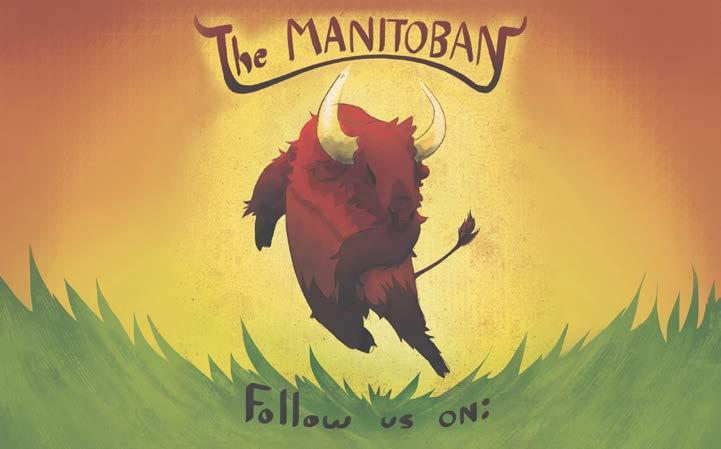
27 arts@themanitoban.com March 1, 2023 Arts & Culture
photo / Matthew Merkel / provided
“
By the end of the show you should be texting your ex”
19
Matthew Merkel, Host of Scary Hours on UMFM
A play within a play on Royal MTC stage
Dramedy Trouble in Mind captures day-to-day realities of racism
Jessie
Krahn, staff
Alice Childress was almost the first Black woman playwright to have her work appear on Broadway in 1955 with her wry and potent meta-comedy Trouble in Mind
But when producers requested a happier ending and a name change that would appeal to white audiences, Childress declined. The play would not see the light of Broadway for more than 60 years.
Childress was staunchly principled and an ardent unionist. The first time Trouble in Mind hit the stage at Greenwich Mews Theatre, Childress did bend to producers’ requests to write an ending that suited them, but only because she did not want to put the cast and production team out of work.
Ironically, Trouble in Mind’s main character navigates racism in the theatre of an almost identical kind to what Childress dealt with in writing the play.
The play follows Wiletta Mayer, a Black actress utterly enamored with theatre. Wiletta is almost Childress’s inverse. She is constantly conscious of her white colleagues’ and directors’ delicate egos, and she is willing to be a yes-man so long as she can spread her wings on stage.
But when Wiletta is cast in a hokey play packaging antiBlack racism in troublingly stereotypical, feel-good wrapping, she winds up at odds with the play’s white director. What little camaraderie the play-within-the-play’s Black and white cast and crew members build is rife with friction.
Trouble in Mind does not present racism as a cold extreme centralized in one villainous white figure whom white audiences can easily
distance themselves from. Rather, the play explores the way that racism is embedded within ordinary people’s interactions.
The play is full of levity too. Wiletta and her colleagues are relatable and flawed, and together their group dynamic yields some hilarious outcomes. Their relationships are refreshingly distinct from the gratuitously simplified and strained ones between white and Black characters in the kind of stories that Childress’s own contemporaries pushed her to write.
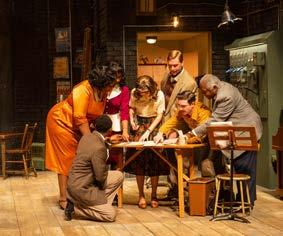
The result is a play that is true-to-life. None of the characters live in perpetual misery, but there is no comfortable resolution here either.
The entire cast of Royal Manitoba Theatre Centre (Royal MTC)’s run of Trouble in Mind give immersive and iridescent performances.
Alana Bridgewater exudes fierceness and passion as Wiletta. Andrew Broderick, Reena Jolly and Jodi Kristjanson are wholly believable as the younger generation and their chemistry feels authentic. Geoffrey Pounsett is arrest-
Richards said.
“I find myself saying the things the director says in the play, and the actors and I are responding in the same [way], so it’s very meta. That’s what we call it when life meets art meets life.”
Richards was interested not only in “how beautifully human” the play’s characters are, but also in the tension that arises between them.
“That’s the exciting thing about this play, is to see how these characters fight for what they want, fight each other, fight for themselves, fall or succeed in their own efforts and battle their own insecurities and fears just as we all do as actors and artists,” Richards explained.
Richards hopes that the play will motivate audiences to learn more about marginalized artists and to share stories that have historically been omitted from mainstream stages.
ing as the hard-headed director Al Manners, and Alvin Sanders of Riverdale fame is endearingly funny as Sheldon Forrester.
According to the director of Royal MTC’s run of Trouble in Mind Cherissa Richards, the cast is very invested in the show. Speaking with the Manitoban, Richards said that working on the play brought fiction and the realities of stage productions into close contact.
“It’s a microcosm of a backstage, like a bird’s eye view of how a rehearsal room works,”
“I love hearing audiences going away, ‘oh, I want to Google that,’ or ‘I want to look that up’ or ‘wow, I didn’t know that about that playwright,’” she said. “It inspires you to go do your own research into the play and maybe do your own research into what is happening in the world in social justice at the moment.”
Richards also hopes that audiences will be prompted to ask themselves, “how can I create more art that tells these stories or support great art that tells these stories so that they don’t go unheard?”
As a Black Canadian woman, Richards expressed an interest not only in stories from Black communities in America but in stories that represent Black Canadian communities specifically.
“What are our stories, and how do we tell our Canadian stories that are just as visceral,

just as prescient as the stories that we’re telling in this play?” she asked.
Being a play with a Black woman as its main character that was written by a Black woman, Trouble in Mind is significant for Richards.
“As a Black woman, I’m very much aware that my stories can often go unheard and untold,” she said. And in telling this story, Richards expressed that all involved share a palpable enthusiasm.
“This entire cast is so strong
and supportive and all-in. I think that’s the most exciting thing about it, is everybody is all-in. And when you have a group of people working together who are that passionate about a project, you can’t lose.”
Trouble in Mind runs at the Royal MTC until March 11. For tickets, visit royalmtc.ca.

28 arts@themanitoban.com Vol. 109, No. 23 Arts & Culture
photos / Dylan Hewlett / provided
“This entire cast is so strong and supportive and all-in”
20
Cherissa Richards, Trouble in Mind director
arts@themanitoban.com
Herd swims to podium finishes in Victoria
Bisons swim team competed in U-Sports championship over reading week

Quinn Mayhew, staff
The U-Sports national swimming championship kicked off this past week, beginning on Feb. 23, in Victoria, B.C., and continuing through the weekend to the 26. This was the annual premier swimming competition, and Bison swimmers sure had some fast times for the herd.
The meet was a huge success for graduating swimmer Dora Modrcin in particular. This meet was her last varsity swimming competition. Modrcin went on to compete in four individual races and two relays.
Modrcin was on the top of her game this meet. When it came to earning medals and making finals, she was an instrumental and indispensable part of the swim team.
Modrcin went on to win two medals this competition, a third-place finish in the 50-metre backstroke with a time of 29.68 and a second place finish in the 50-metre butterfly with a final time of 27.49, ending the competition with a total of 67 points.
Ultimately, Modrcin dominated this competition for Bison athletics, ending her varsity career with a monumental closing.
Another prolific Bison in this competition was third year graduating swimmer Megan Mozill, who ended her varsity swimming career with the competition this past weekend.
Mozill competed in four individual events along with two relay swims, making finals in most of her individual events and completing the competition with 34 total points. Mozill truly ended her varsity career on a high note.
Second year Hannah Schanel, whose performance in the 50-metre freestyle stood out with a time of 26.99, placing 12th overall, was also an asset to the herd. She contributed 14.5 points to the team’s overall score.
When the U-Sports championship ended, the women finished in seventh place with a blazing 302.5 points. The men finished in 20th place with a total of 15 points.
The Bison swim team wrapped up its varsity season this past weekend, and looking back on the year, there was both fast swimming and a sense of unity between teammates as the team displayed a sense of togetherness that helped fuel the herd to medal-winning finishes.
As both Mozill and Modrcin are leaving varsity Bison athletics after this year, they will leave the swim team with shoes to fill, for both phenomenal athletes were big point scores and medal winners for the swim team. Both women placed in the finals and qualified for premier meets consistently.
However, with these two seniors leaving, opportunities will be granted to incoming swimmers and rookies who will look to fill the absence of these women in the following months.
sports@themanitoban.com

29 sports@themanitoban.com March 1, 2023 Sports
21
photo / Faith Peters / staff
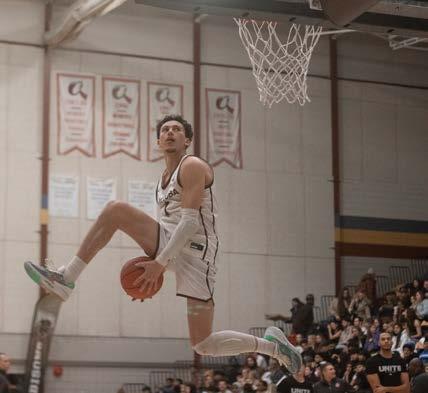
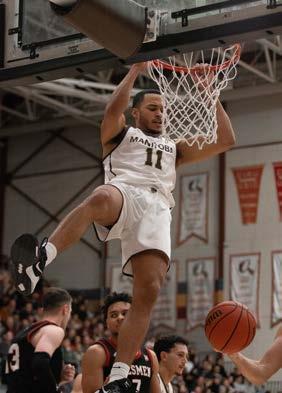
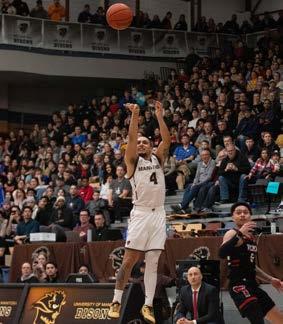
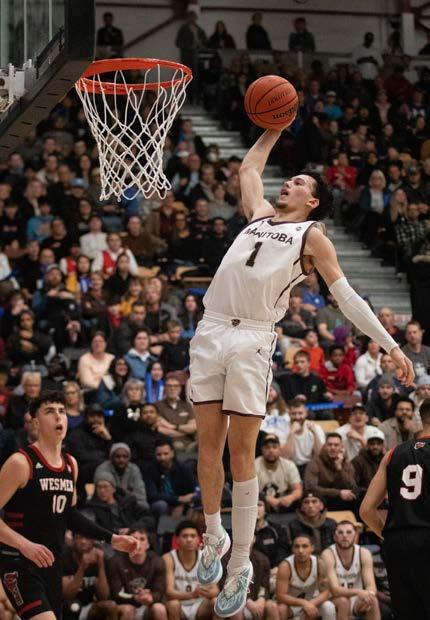
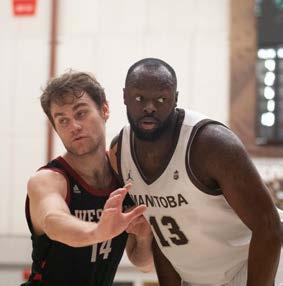
30 sports@themanitoban.com Vol. 109, No. 23 Sports photos / Matthew Merkel / volunteer 22
Bison briefs
Joshua Brandt, staff Volleyball
Both the women’s and men’s volleyball teams qualified for the CanWest playoffs this 2022-23 season. Each team played a best-of-three quarterfinal this past week.
The women finished in sixth place in the conference, garnering a quarterfinal matchup against the third place University of British Columbia Thunderbirds (UBC). The men just squeaked in, finishing in eighth place, meaning they had a daunting quarterfinal date with the first place University of Alberta Golden Bears (U of A).
The women’s volleyball team played the role of the underdog this past weekend, snatching the first game of
their series and putting UBC on upset alert.
The game was a roller coaster five-set thriller, capped off by a huge solo block by Brenna Bedosky.
Feb. 25’s match saw the Bisons emerge victorious again, completing the upset over the Thunderbirds by sweeping the best of three series two games to none. The herd won the decisive match three sets to one.
Rookie sensation Raya Surinx had another outstanding performance, facilitating the Bisons’ win with 23 kills.
Hoping to keep their magic alive this weekend, the women will play another best of three series in the CanWest semifinals against the second place University of Mount Royal Cougars.
Going into their quarter final match against the reigning U-Sports National Champion Golden Bears, who had only dropped two games all year, the men’s task of beating U of A seemed extremely improbable.
And in the first game on Feb. 23, the Golden Bears’ superiority showed.
The team beat the Bisons 3-0, holding them below 20 points in each set.
Nicoles Carter accumulated 9 kills, hitting .100 — the best of any Bison — which is a testament to the Golden Bears’ defence.
The match on Feb. 24, however, was a major volte-face.
The Bisons still lost, yet they played like a team with nothing to lose. They gave the Golden Bears a much closer

Heartbreaker at home
Bisons lose to Wesmen in semifinal game
Joshua Brandt, staff
With an automatic bid to the U-Sports Nationals and a trip to the Canada West conference (CanWest) championship game on the line this past Saturday, Feb. 25, the University of Manitoba men’s basketball team faced off against the University of Winnipeg Wesmen (U of W) in a clash of fierce conference rivals.
Manitoba took down the University of Calgary Dinos 75-72 in its quarterfinal game on Feb. 18, while the Wesmen thwarted fellow Manitoban neighbour University of Brandon Bobcats 87-84.
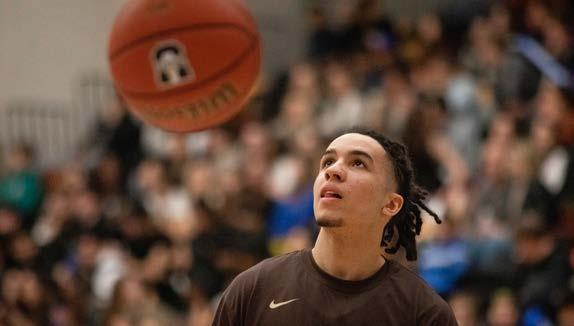
Before the semifinal game, the tension and sheer excitement it caused was palpable. Investors Group Athletic Centre (IGAC) was sold out and raucous. Bison and Wesmen supporters were both extremely vocal throughout the game. One could hear the din from the parking lot, and the noise would factor in significantly as the game progressed.
The Wesmen outplayed the Bisons in the first quarter, however, the herd thundered back to control play in the second.
When the half-time buzzer sounded, both teams went to their locker rooms with 39 points apiece.
Unfortunately, a blown call influenced the outcome of the game. Early in the fourth quarter, Wesmen Alberto Gordo sunk a layup to give the U of W its 61st point of the evening. However, it shouldn’t have
counted. The noise in IGAC was so deafening that the referees claimed they didn’t hear the shot clock buzzer go off, indicating the Wesmen had exceeded the allotted time to get a shot off.
The blunder went unremedied and the basket stood – much to the chagrin of the loyal IGAC faithful and head coach Kirby Schepp, who clapped his hands together in vexation following the missed call.
Ultimately, however, there was still a lot of basketball to be played.
Despite trailing by as much
game, taking the number one team in CanWest to five sets after rattling off two straight when they were down 0-2.
The fourth set in Feb. 24’s match was undoubtedly the most exciting from a Bison point of view. The herd took the seesaw affair 28-26.
The U of A put its foot down in the fifth, however, taking the match three sets to two.
Ultimately, the Bisons put up a valiant fight against the CanWest number one ranked team. They can feel good about their performance given the competition they faced.
In his final collegiate game, Jack Mandryk played his heart out, distributing 45 assists.
And Eric Ogaranko also added 12 kills, finishing the year with 236 of them.
Looking ahead, both
Bisons teams are very young, so expect them to improve in the coming years. Making the playoffs this season is just a step in the right direction, and, for the women who advanced to the semifinals, they’ll look to keep on steppin’.
sports@themanitoban.com
after controversial counted basket
as six with eight minutes left in the contest, the Bisons clawed their way back into the game, taking the lead 65-63 on an Isaac Miller-Jose layup with five and a half minutes remaining.
The Wesmen roared back, however, when the aforementioned Gordo nailed a near half-court desperation three as the shot clock was expiring, giving the U of W a 72-66 lead.
Again, Manitoba managed to close the gap, bringing the score to 72-70. The Bisons then fouled a Wesmen player so as to get the ball back. Donald
Stewart made one of two free throws, meaning the Bisons could still tie the game.
With just five seconds remaining, the Bisons had the ball. Coach Schepp drew up a play for Elijah Lostracco, who got a good look at a triple, which would have tied the game. He missed it left, however.
As a result, the Wesmen stunned the Bisons 73-70, advancing to the CanWest championship game against the University of Victoria Vikes.
Ultimately, missed three pointers did the Bisons in, as
they went a dismal 2-28 on the evening.
Yet, the U of M may still make the U-Sports National championships. However, their future isn’t in their own hands, as they’ll need to be selected for an “at-large” bid. Now, only time will tell if the herd’s remarkable season will continue.
sports@themanitoban.com
31 sports@themanitoban.com March 1, 2023 Sports
23
photo / Matthew Merkel / volunteer
The end of a hockey season and of an era
A look back on coach Sirant’s last season with the Bisons
Joshua Brandt staff
The U of M men’s hockey team finished its season entrenched in eighth place in the Canada West conference (CanWest) standings, two points shy of a playoff spot.
Additionally, head coach Mike Sirant’s coaching tenure ended when the team missed the playoffs. Earlier this year, Sirant announced that he would be retiring sometime in June.
While the herd missed the playoffs, there were certainly highlights from the season.
The U of M’s best player during the 2022-23 season was forward Brett Davis. Davis had joined the Bisons for the 202122 season after a cup of coffee with the Manitoba Moose.
For his efforts this past season, Davis was named a CanWest second team all-star. In 23 games, the second-year stud racked up a team-leading 29 points including 11 goals.
While Davis finished 14th in CanWest scoring, the Oakbank, Man. native produced 1.26 points per game, which was eighth best in CanWest.
The team’s second leading scorer was Devon Skoleski, who also slotted home 11 goals and finished the 2022-23 campaign with 27 points in 27 games.
Chase Hartje was the Bisons’ most prolific defenceman, chipping in with 20 points and 14 apples.
Jonny Hooker was the Bisons’ leading rookie point scorer, finishing with 10 points. Before joining the Bisons this year, Hooker was the captain of the Western Hockey League’s Prince
George Cougars.
In net, second year Ross Hawryluk got the majority of starts, appearing in 22 games, posting lacklustre stats. Hawryluk had a goals against average of 4.06 and a sub .900 save percentage, while notching seven wins.
Nevertheless, Hawryluk did face the second most shots against in the regular season, which may incline some to forgive his less than stellar numbers.
In an interview with the Manitoban about the Bisons’ season, and his last, a pensive Sirant took time to contemplate each question before answering with candor.

While conceding that “it was a tough season,” the Bisons’ absence from the playoffs “wasn’t from a lack of effort from our players and coaching staff,” Sirant said.
“Every game, regardless of the score or what happened the previous night, our players competed hard.”
Despite the team’s poor record, “our players stayed loyal to each other and really cared for one another,” Sirant said.
“We competed and stayed in the fight, and that shows a lot of character and a lot of resiliency.”
“Even in games that we were losing, players were still out there blocking shots late in the game, sacrificing,” he stated.
“When you don’t have the success that you’re striving for, you always look at the opportunity to reflect and learn from it,” he explained.
“And that leads to your personal growth, because hockey,
like life, it’s not always going to go the way you hope or expect, but the key is what you’ll learn from that experience, that’s going to make you better as a person.”
Looking on the bright side, Sirant drew attention to a few season highlights: playing against division one NCAA competition — St. Cloud State and the University of North Dakota — and, of course, the game against the Ukrainian U25 National Men’s Hockey Team, “games that we’ll remember all our lives,” Sirant noted.
Concerning the aforementioned game against Ukraine, Sirant said, “it really was an amazing evening.” He recalled how many people contacted the Bisons after the game, “saying that they’ll never forget that night and how proud they were to be Winnipeggers and Manitobans.”
The game had an undeniably powerful impact. Sir-
ant noted that its purpose was “to remind us the people in Ukraine still need our support, in terms of humanitarian aid.” He added that the game “really lifted the spirts of people both here in Canada and in Ukraine.”
Canada Life Centre was “packed with recent Ukrainian refugees and people in Ukraine were following the game back in Ukraine and they were overwhelmed that people in [...] Canada were so supportive of their cause,” Sirant added.
Roughly 8,000 people attended the Jan. 9 game, the majority of which were Ukrainian refugees for whom the U of M provided complementary tickets.
The game also raised funds for Ukrainians, while financing the promotion of hockey in the country.
been blessed to work with that really enriched my life.”
Out of all his accomplishments, Sirant feels that helping the players he’s coached “be successful in their careers and positive contributors to our community” is truly invaluable.
When asked what a piece of life advice he’d give to his younger self would be, Sirant said, “work really hard, find something that you are passionate about, be humble, respectful and grateful, always pursue learning and strive for continuous improvement, and be a servant leader, which is having an awareness for opportunities to serve others.”
And a servant leader he was. The Bisons hockey program will surely miss him. The Manitoban wishes him all the best in his retirement.
Looking back on his internationally dotted career, Sirant fixated on “the memories of so many people that I’ve sports@themanitoban.com
Sports teams’ schedules
U
— Women’s Volleyball
U
— Men’s Basketball
Mar. 8 — 6:30 p.m.
32 sports@themanitoban.com Vol. 109, No. 23 Sports
Bisons
Bisons @ Calgary Dinos Feb. 17 — Final: 3 – 0 Bisons @ Calgary Dinos Feb. 18 — Final: 0 – 3 CanWest Quarterfinals (best-of-three): Bisons @ UBC Thunderbirds Feb. 24–25 — Finals: 3 – 2, 3 – 1 CanWest Semifinals (best-of-three): Bisons @ Mount Royal Cougars Mar. 3–5
of M
of M Bisons
CanWest Quarterfinals: Calgary Dinos @ Bisons Feb. 18 — Final: 72 – 75 CanWest Semifinals: Winnipeg Wesmen @ Bisons Feb. 25 — Final: 73 – 70 U of M Bisons
Volleyball Bisons @ Calgary Dinos Feb. 17 — Final: 1 – 3 Bisons @ Calgary Dinos Feb. 18 — Final: 0 – 3 CanWest Quarterfinals (best-of-three): Bisons @ Alberta Golden Bears Feb. 23–24 — Finals: 0 – 3, 2 – 3
of M Bisons — Swimming Man./Sask. Championships Mar. 2–5 Winnipeg Jets Jets @ Edmonton Oilers Mar. 3 — 8 p.m. Edmonton Oilers @ Jets Mar. 4 — 6 p.m. San Jose Sharks @ Jets Mar. 6 — 6:30 p.m. Minnesota Wild @ Jets
— Men’s
U
* All times CST
24
photo / Matthew Merkel / volunteer





















 Distinguished Lecture
Distinguished Lecture






















 by: Colton McKillop, Kasey Pashe, Alicia Rose, staff
by: Colton McKillop, Kasey Pashe, Alicia Rose, staff













































 photos: Ebunoluwa Akinbo, staff
photos: Ebunoluwa Akinbo, staff
 SYLVIE FOIDART | TOURISM COORDINATOR ECONOMIC DEVELOPMENT COUNCIL FOR MANITOBA BILINGUAL MUNICIPALITIES (CDEM) GRADUATE OF TOURISM MANAGEMENT ST. BONIFACE UNIVERSITY
SYLVIE FOIDART | TOURISM COORDINATOR ECONOMIC DEVELOPMENT COUNCIL FOR MANITOBA BILINGUAL MUNICIPALITIES (CDEM) GRADUATE OF TOURISM MANAGEMENT ST. BONIFACE UNIVERSITY


















